 By Staff By Staff
BURLINGTON, ON January 22, 2013 Regional chair Gary Carr is very big on telling people he wants to hear what they have to say and he usually takes what he hears into consideration when he makes decisions. What Gary Carr rarely does it “rock the boat”. It just isn’t in the man – even though there are some regional issues that could use a tougher stand.
The Regional Chair is the person who can and should go up against the province on behalf of all the municipalities in the Region – that doesn’t happen often enough.
A significant number of the roads in each municipality are considered Regional roads. There is a new water main going in along Lakeshore Road in Burlington that is going to disrupt traffic and while local residents will call their local council member – it’s a regional issue over which the city has no control.
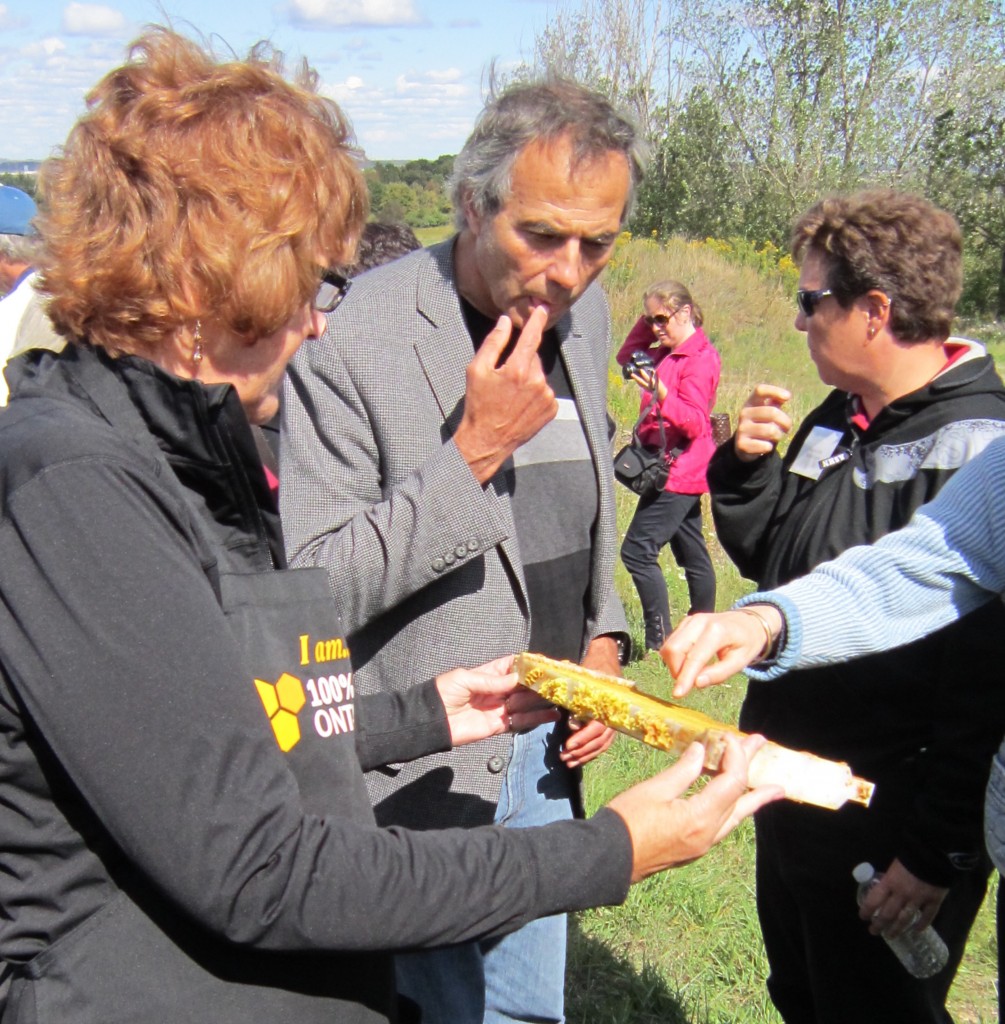 Regional chair Gary Carr tastes some raw honey while on a farm tour. The sweet spot for all politicians is getting people to talk to them, which the Region hopes you might do by giving them your point of view. There are other construction projects taking place – work along Dundas is another example, and the Region wants to know if you’re happy (content is another word they might use) with the way information is being conveyed to you.
At the end of the month the region is going to release a new survey to evaluate the effectiveness of its communications efforts in support of regional infrastructure planning and construction projects.
The survey is part of the ongoing Halton MVP (myViewPoint) survey series that asks an online panel of Halton residents for input on Regional programs and services. The survey results will be used to improve the Building a Better Halton communications program.
“Construction affects all of us in Halton Region,” said Regional Chair Gary Carr. “Our goal is to provide residents, businesses and commuters with useful and timely information that will help reduce the impact of Regional construction on drive times and daily life throughout the region.”
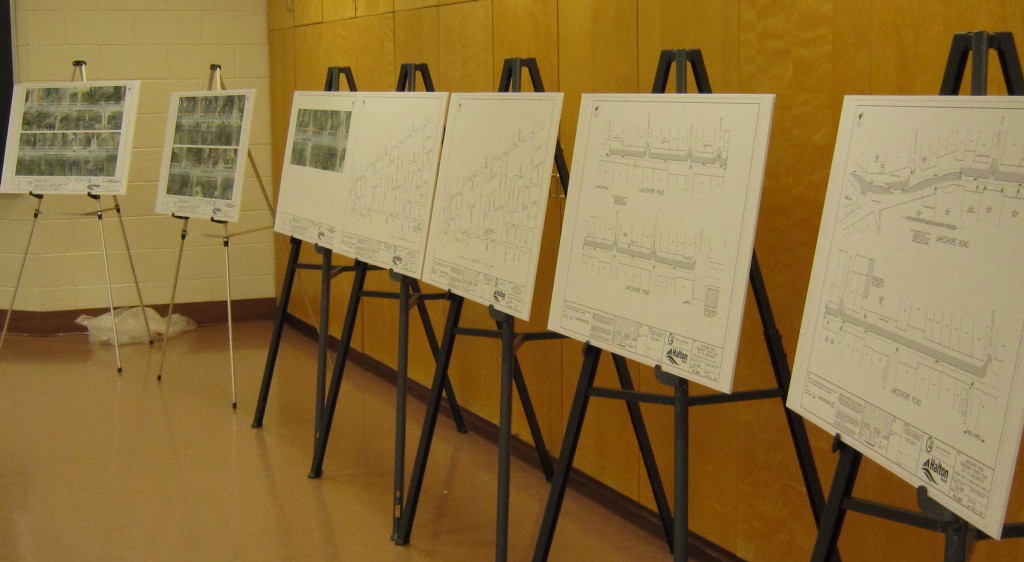 Part of communicating with the people who pay the bills is sharing information. The Region is replacing a water main on Lakeshore Road east of the downtown core that is going to curtail traffic during the summer months. The Region requires the contractor to get out into the community with charts and pictures showing what is being done and how it is being done. To take part in Halton MVP surveys, residents must join the survey panel and complete a demographic questionnaire. Panelists may be invited to participate in up to eight surveys each year on a variety of Regional programs and services.
Registration is open to all residents of Halton Region (excluding employees of Halton Region) 18 years of age or older. To register, or for more information about Halton MVP, visit www.halton.ca/MVP.
To participate in the next survey on construction communications, eligible Halton residents must join the MVP panel by Sunday, January 27, 2013.
The Halton MVP survey panel is managed and administered by Jane Armstrong Research Associates on behalf of Halton Region through a secure website. All correspondence, data collection and data analysis are the responsibility of Armstrong Research. The names of panelists, or any other identifiable information, will not be released without written permission by the participant. Individual views will remain anonymous and data will always be analyzed and presented to Halton Region in the aggregate.
With the technology now available, governments can reach out and ask questions and get a sense of what people think and feel about something the government wants to do. It’s good governance and it’s very good politics – and if Regional Chair Gary Carr is anything – he is a very astute politician.

 By Pepper Parr By Pepper Parr
BURLINGTON, ON January 17, 2013 Parking in the community east of Appleby Line and north of Mainway is impossible. The houses were not designed for the parking that residents now need. The garages are too small for most cars and driveways are not all that big which for residents in the community amounts to parking tickets.
The real world of the people in this community is experiencing a very hard bump into the city’s three hour parking limit on city streets, which has been in place for 20 years. And it is hurting.
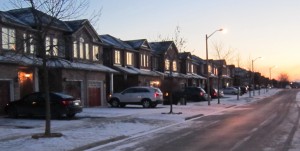 Looks OK on this side of the street. Relief is possible and Councillor Paul Sharman pushed through a Staff Direction asking the city staff to provide a report council can vote on at their end of the month meeting allowing the people in the community to decide if they want on-street overnight parking.
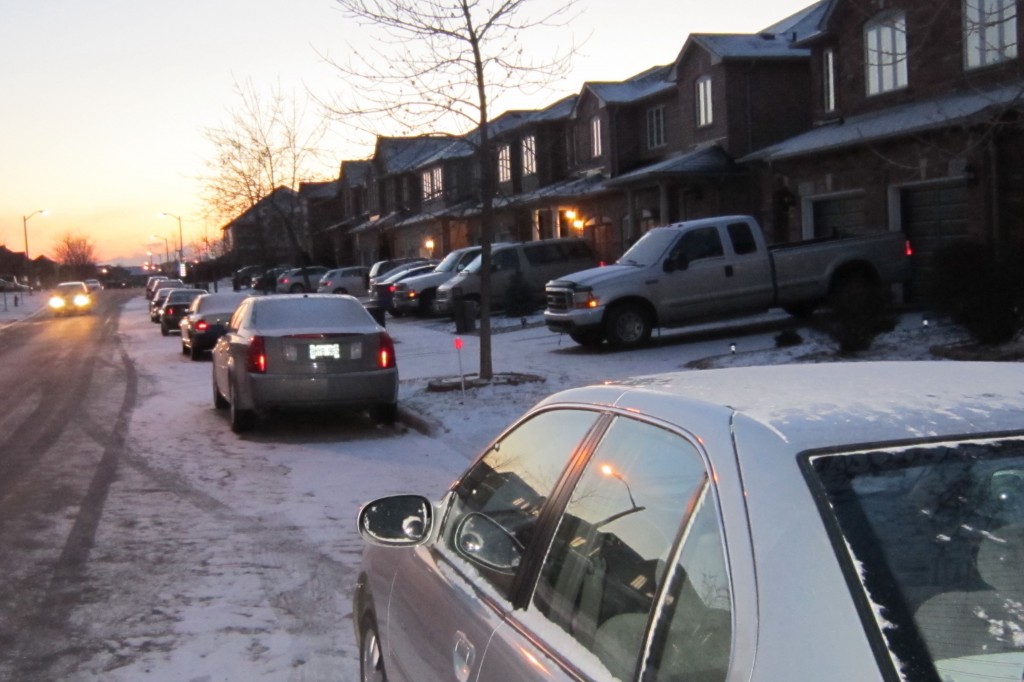 The story isn’t the same on this side of the street.
The city has what they call the NOSPP Neighbourhood On-Street Parking Program that allows a neighbourhood to petition city hall to allow overnight parking.
What does the City have in place now?
The existing 3-hour Parking By-law will still apply on a city-wide basis, excluding specifically the areas that are approved to participate in the NOSPP. The City will continue its current practice of accommodating specific needs of residents.
The Neighbourhood On-Street Parking Program (NOSPP) will let residents park on the street in front of residents homes for extended periods of time (either weekends only or 7 days/week, 24 hours/day or overnight from 1 a.m. to 6 a.m.) The policy was approved on a city-wide basis by Council on January 15, 2001, amended on May 20, 2003.
The NOSPP allows a minimum group of 10 residents (both sides of the street) or an entire street block to apply for extended on-street parking. The required criteria to qualify for NOSPP are outlined below:
Any “parking zone” within the City may apply for extended on-street parking by obtaining a package from Parking Services. A minimum of 75% support must be achieved within the designated parking zone in order to qualify.
There are several categories:
Category 1 – Weekends Only: To allow visitor parking over the weekend, for longer than the standard 3-hour parking limit. Automatically qualify for Weekend Parking if the NOSPP criteria are met, permitted times are between Friday at 6:00 p.m. and Sunday at 12:00 a.m. (midnight).
Category 2 – 7 days/week, 24 hours/day: To accommodate residents who are faced with inadequate off-street parking facilities. Must demonstrate to staff that inadequate off-street parking facilities exist. By definition, the term “inadequate” refers to 1 or less spaces designated for off-street parking.
Category 3 – Overnight: To allow overnight parking, from 1 a.m. to 6 a.m. daily. Must demonstrate to staff that inadequate off-street parking facilities exist. By definition, the term “inadequate” refers to 1 or less spaces designated for off-street parking.
Existing Residential Parking Regulations govern over this program; for example you may not park in a currently posted “No Parking” or “No Stopping” zone or within 3 metres (10′) of a fire hydrant;
Long term on-street parking will only be permitted on local and collector residential streets;
The NOSPP is in effect from January 1st to December 31st, however, no vehicles shall be parked in the designated NOSPP zone during winter control activities. To ensure efficient snow removal, all vehicles must be accommodated off-street until such time the street has been cleared of snow. Under the provisions of Uniform Traffic By-law 1984-1, as amended, any vehicles found to be parked in the designated zone during these activities will be subject to tagging and/or towing of the vehicle(s) at the owner(s) expense
Residents must pay the cost to manufacture, install and maintain appropriate signage. A one-time fee of $200 will be charged, which may be apportioned amongst participants. This fee must be received prior to the City issuing the work order to have the signs installed. The City will be responsible for the ongoing maintenance of any signs after installed;
Traffic flow must be maintained at all times.
The NOSPP is available for one side of the street only (and vehicles must still park facing the proper direction of travel). Parked vehicles are not permitted to block driveways.
Should removal of the NOSPP zone be requested at a later date, the same homes must be re-surveyed, and a minimum of 75% of those homes must be in support of the removal.
On-street parking spaces within the approved areas are not reserved and shall be used on a first-come, first-served basis.
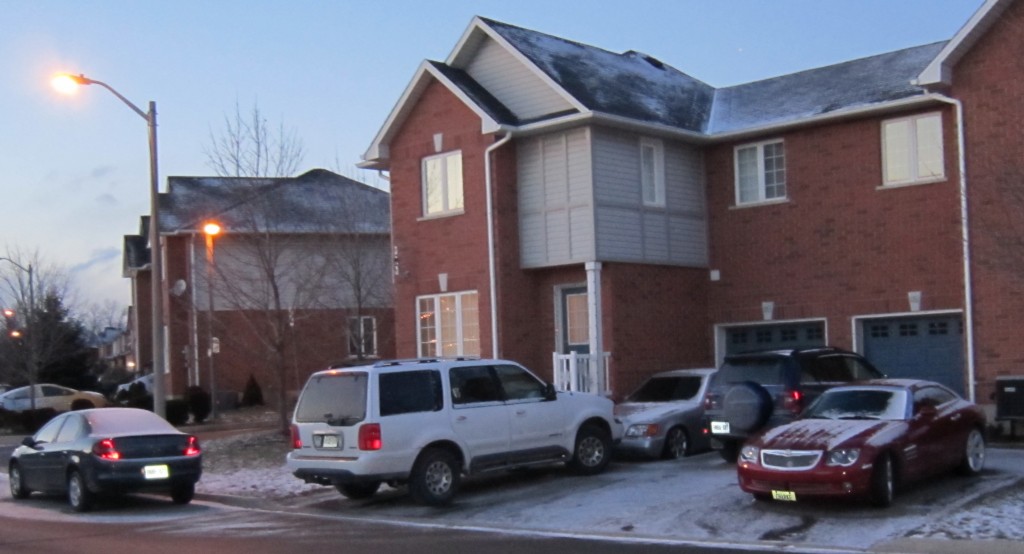 Garages for these homes are too small for the cars. Planning might have dropped the ball when the project was approved. That doesn’t do anything for the people in the community east of Appleby Line and north of Mainway where parking tickets have become a way of life. The 7 day/week, 24 hour/day option is not designed to provide extended on-street parking for households with more than 2 vehicles, or to promote the use of available garage space as storage. The purpose of this option is to allocate on-street parking to those who genuinely require it, as they lack adequate off-street parking facilities.
Sharman has been dealing with constituent complaints on this problem ever since he was elected to office. He just might have found a way to solve a problem for some of his resident.
Resident can get additional information at city hall – 905-335-7600 Ext 7560
Best to wait until this has cleared the city council meeting on January 28th – then you will need to talk to your neighbours and get them to sign the petition requesting the on street parking option.

 By Pepper Parr By Pepper Parr
BURLINGTON, ON. January 21, 2013 They were all there. Those that farm the rural part of Burlington; those people that live in the community and don’t want to see all that much change. The stop the Escarpment highway people weren’t out in force but they were there as well. The politicians that work the territory were in the room. And loads of staff people
The meeting took place in the elementary school in Kilbride and was part of the public process in figuring out how our Official Plan should be changed.
Every city in the province has an Official Plan that it must revise every five years. Some of the reviews are a “lick and a promise” and Burlington has had a few of those but this time out the city wanted to do some digging and begin asking the taxpayers just what they wanted their city to look like in 25 years.
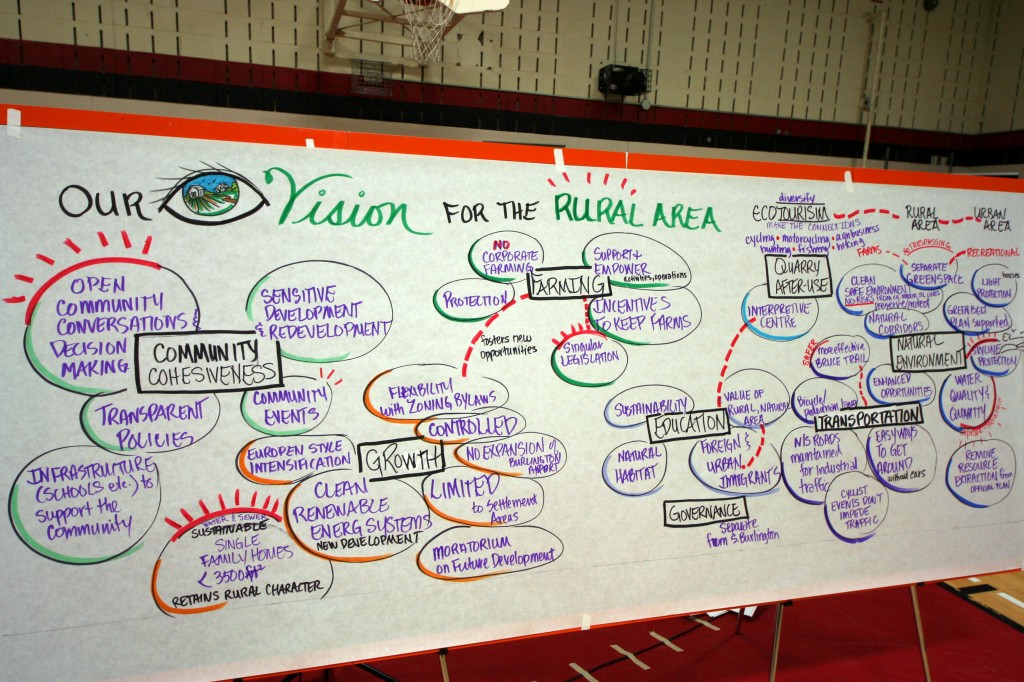 The vision for Rural Burlington as captured by a facilitator during the Rural Summit that took place at Kilbride Elementary school. Burlington is that odd combination of a well-developed suburban community with small patches of urbaness to it and then a large swath of land to the north that is rural. There are farmers up there that actually earn a living from the land they work.
There are no dairy herds; the last of the all-purpose farms went some time ago but there are people who take off quality hay and the equestrian sector is active. Strawberry farms do a decent business as well. But there really isn’t a farming community and while many people talk about reviving that part of the economy it is not likely to happen in rural Burlington.
What is happening is the development of large properties with houses that have in excess of 5,000 square feet and both indoor and outdoor swimming pools. Some of these properties are built on 15, 25 and 40 acres properties with a portion of the land taxed as residential housing and the rest taxed as farm land – with the land rented out to local farmers who are quite content to take hay off land that they rent. No long term investment and rents that are quite reasonable.
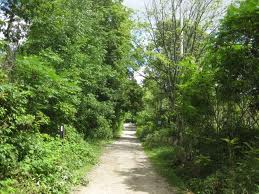 This is the rural Burlington residents want to keep – walking trails and quiet countryside. There is a farm on the north side of Dundas that thousands of people drive by weekly without knowing there is a pear farm up there with trees that are more than 100 years old.
For those who live in north Burlington there is always the sense that the lifestyle is being threatened. There are property owners with holdings on the north side of 407/Dundas who fully expect to sell out to a developer. There are people in the Burlington Economic Development office who see opportunities to develop the north side of 407.
The Region says that isn’t going to happen and the province says it can’t happen – but things change and over time many believe that they will see encroachments on what are now rural lands.
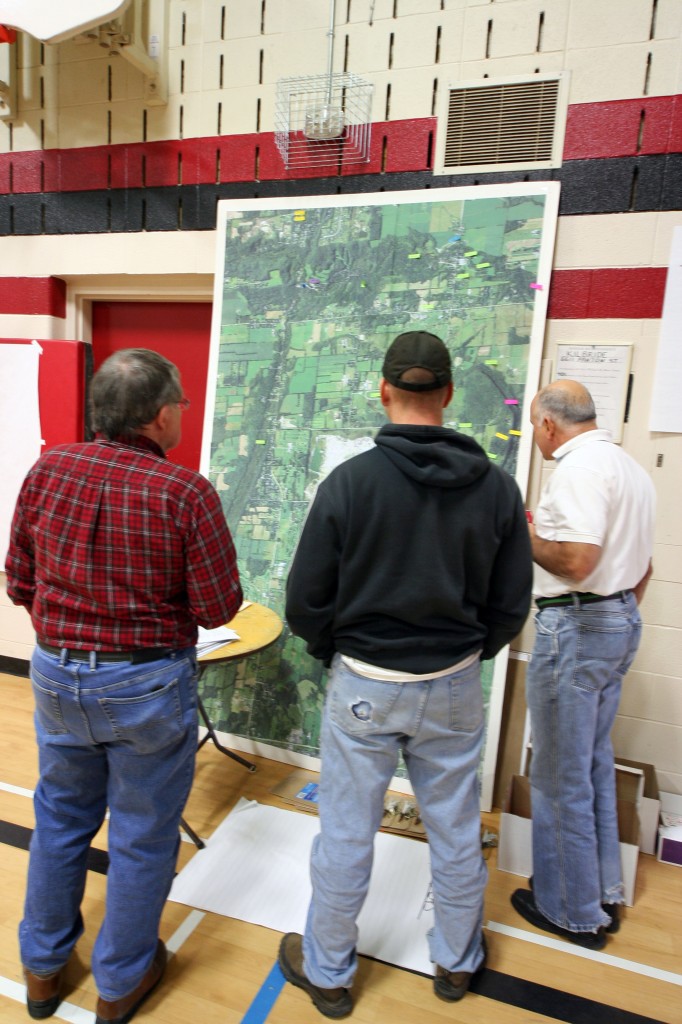 This is what rural Burlington is all about – large fields, small farms and people wanting to maintain a lifestyle. The boundary between suburban and rural used to be Dundas Street – the Old Hwy 5. When the 407 got built that boundary shifted and we saw the Alton Village community develop.
While any Niagara to GTA road is certainly on hold for now – the province has been consistently thinking about where a road can be built to handle all the traffic that wants to get to Windsor and Niagara Falls to cross into the United States.
The bulk of what Ontario produces get shipped to the United States and much of what we consume comes from the United States and heads into that huge GTA market. To get to and from that American market trucks need roads and the QEW has just about reached its peak.
The people who do the long term economic development thinking look at the Escarpment and think they could run a road through that part of Burlington.
John Taylor who is the biggest asset the city has when it comes to fighting for rural Burlington has taken the position that what comes out of the province in terms of policy doesn’t have to become the law of the land. He firmly believes that the public can talk back and points to the success with the application to enlarge the Nelson quarry – that application was denied and while the wish on the part of the aggregate people to be able to dig out rock and ship it to Toronto hasn’t had a dagger put through its heart yet – the chances of Burlington ever seeing another quarry developed on the Escarpment are very, very slim.
What the city and the Region – include the province in that – have to do is determine just what they want to do with the existing quarry once it is mined out. There are a number of long term opportunities here that the rural community can get behind and be very proactive in determining how their community evolves.
Last Saturday some 125 people met and talked; they made notes and exchanged ideas under the guidance of a good facilitator. What she didn’t do – and many wished she had done was ask people to identify themselves – if not by name then by where they lived. It helps when one has a context into which they can put the remarks being made.
One woman wanted the community to both empower the agricultural sector and support what they want to do. The sense I got from listening was that the agriculture community doesn’t have a vision other than to be left alone. There wasn’t any comment from anyone who identified themselves as a farmer – even though there were quite a few of them in the room.
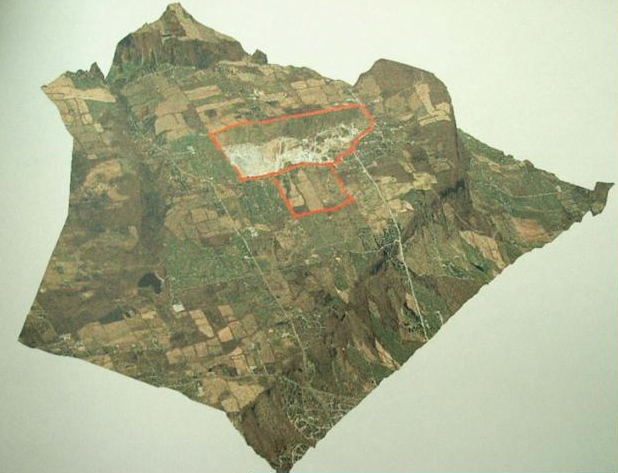 The orange outline at the top of this topographical map is where the current quarry is located. That mine is nearing being mined-out. The smaller outline is where Nelson Aggregates wanted to open a new mine. The application for a permit to do that was denied – a huge step for the rural community. Ecotourism was mentioned several times – but other than tossing out the phrase there wasn’t much more meat on that bone. One lady suggested opening up B&B’s – great idea and there isn’t a thing stopping anyone from putting out a shingle today. But even a dozen B&B’s aren’t going to make much of a difference to the local economy or the health of the community. They won’t hurt and if done properly they would introduce more people to what we have and those visitors would speak well of our rural north.
This is the time to do that thinking and at this point there isn’t all that much quality thinking being done. Nemo 7G is in place but other than a large poster that I couldn’t make much sense out of – they’ve not come forward with very much. They do want to think ahead for seven generations – which is laudable, great if they can do it – but we’re not seeing it yet.
Environmental issues are always on the front burner for the people who live rural lives. They know what they have and they know how quickly it can be destroyed. The quarry battle has been fought and won; the Stop the Escarpment Highway battle has been fought to a win – sort of. One never knows what the bureaucrats are thinking and the people paying the bills are usually the last to know.
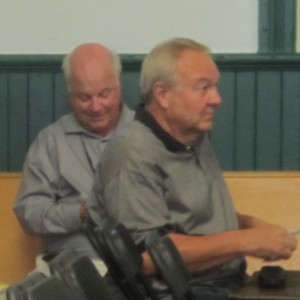 Ward 3 Councillor John Taylor, the person who probably works hardest to ensure that rural Burlington does not get turned into another suburb sit with John Timmis at the Lowville school house. Taylor wants to change that and he knows that if he can mobilize the community a significant difference can be made. It takes a lot of work on the part of citizens to attend meeting after meeting and struggle to raise the funds needed to fight powerful interests. PERL (Protect Escarpment and Rural Lands) is exhausted. They won the fight to prevent Nelson Aggregate from getting another permit to quarry rock out of their holdings at Guelph Line and Colling Road but in the process burnt out a number of people who were heavily involved in the Joint Tribunal hearings that went on for close to a year. PERL won – and the community is grateful – meanwhile PERL struggles with debts and have yet to hold a community wide event to celebrate what is a truly astonishing feat.
This business of fighting powerful, well financed interests can grind you down.
One woman thought there was an opportunity to develop an “interpretive centre” on the quarry site while another related a conversation she had overheard in a coffee shop that had the owners of the Mohawk Raceway putting together plans to turn the quarry site into a resort – convention centre with an upscale hotel. That speaker wanted to see a lot more transparency in whatever gets done.
Some of the people who live in the rural community want more in the way of amenities – “there is no place to walk in Kilbride” said one woman. There are apparently no trails – just roadways.
Just about everyone wanted clean, renewable energy – but no wind turbines; solar was acceptable and geothermal was described as the best deal available.
Bike lanes on Walkers Line – a gotta for these people but not so gotta for the farmers who need to move wide equipment up and down those roads. The Bruce trail needed to make better use of the countryside – too much of the trail is along the roadway in rural Burlington.
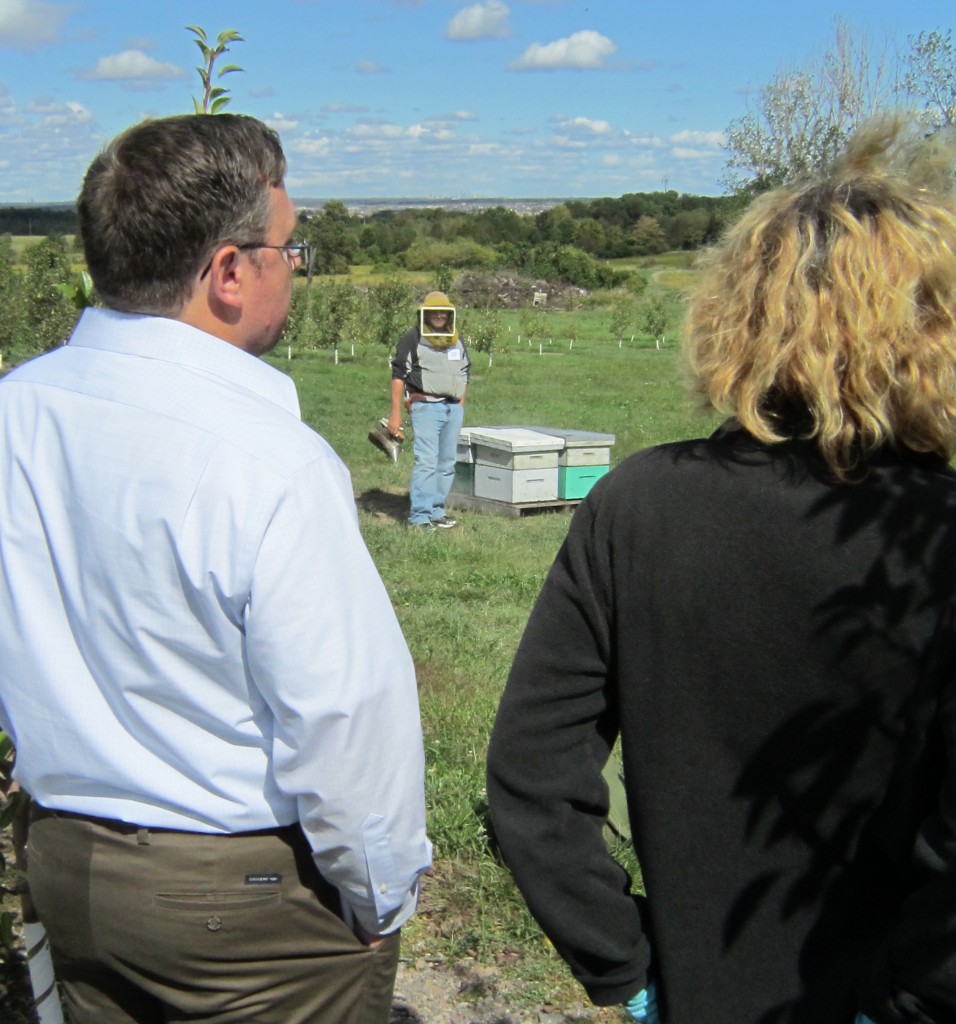 Bee keeper showing people on a farm tour how the bees are maintained and used to pollinate pear trees on a farm on the north side of Dundas just west of Guelph Line. Thousands drive by the place without knowing how big the place is. Another speaker said there is a strong story to be told about just how economically viable rural Burlington is – with about 2000 homes in the defined area it’s difficult to see an economic core. The sum of the agricultural interest, the services the equestrian community provides, the traffic that Lowville Park attracts and the number of really small farms don’t add up to much in the way of economic activity. The biggest job creator has been the quarry. The golf courses are always busy – but are they placeholders for land that might one day get developed? Do the golf players spend money outside the grounds? The Lowville Bistro is business enough during the season and if properly marketed they could extend their season to close to year round. Is there a reason why there aren’t more decent restaurants in rural Burlington?
Someone within rural Burlington needs to do the homework to tease out the economic base – because it wasn’t at all clear there is one.
The airport can’t be allowed to grow another foot seemed to be the sentiment of the room. Milton might have something they want to say about that and the people who are building the 3500 and 5,000 square foot homes want to be able to get to that airport and fly in and out. They have truckloads of money and they want to be able to spend it on the lifestyle they have chosen – which is to live in a quiet community where they can live behind electrically operated gates and do whatever they want.
That didn’t jive with the several comments about the wish for a cohesive community. The moneyed set don’t want to be part of a cohesive community – they want to be left alone.
The day was divided into two phases with a wrap up session. City hall Planning staff would then take everything back to their offices and begin to make some sense out of it all.
The facilitator did everything they could to get people into small groups – four or five at each table, where they were asked to listen to each other while each talked about what they felt Rural Burlington would look like 20 to 25 years into the future.
A recorder took notes.
Every 20 minutes all of the people at each table, except the recorder, moved to different tables and went through the same exercise but with different people. The objective was for people to listen to each other.
With Phase 1 complete everyone had lunch, which was provided. The facilitator then went through the notes and looked for common themes. They created spaces around the school gymnasium where they put up posters on each of the six themes they had identified.
Tourism, Agriculture, Natural Environment, Transportation, Sustainable growth, Cohesive Community.
People were then invited to take their chair to the theme that interested them the most and get into a conversation with others on what the theme meant to them; what Burlington is actually doing now; what will future generations say we have achieved – then, what are the big ideas – the possible projects.
And that was about as much as one could expect from 125+ residents who met on a cold Saturday to talk about what they wanted their city to include in the next version of its Official Plan.
The city had hoped to complete its Official Plan before the end of the current term. Councillor Taylor has suggested the job may not get completed before the end of the current term of Council.
The “retirement” of a key staff member has called for a number of adjustments that were not planned.
Nisha Shirali. an environmental planner and Alison Enns, the Acting Senior Planner on this project and Andrea Smith, Acting Manager of Policy and Research now get to go back to their offices and figure out what it all means and how to work it into the review of the Official Plan.

 By Pepper Parr By Pepper Parr
BURLINGTON, ON. January 21st, 2013 The Burlington Fire Department is looking for individuals who are interested in a challenging opportunity to serve their community as a volunteer firefighter. Applications are now available. The submission deadline is 11:59p.m., Feb. 1, 2013.
There are a lot of gotta’s with this opportunity.
You must be a Burlington resident and be at least 18 years of age.
Meet the volunteer firefighter requirements as outlined on the city’s website
Be prepared to volunteer your time to training, firefighting and other related duties
The Fire Department consists of both professional and volunteer firefighters. Being a volunteer firefighter is no ordinary job; the work is varied and challenging. New recruits will be assigned to Fire Headquarters, Station No. 1 located on Fairview Street or Fire Station No. 5 located in Kilbride based on where the applicant lives. The Kilbride station covers the rural areas of Burlington, mostly north of No. 2 Sideroad.
For more information about requirements, preferred qualifications and how to apply online.
While firefighting can be dangerous the men and women who do this work are exceptionally well-trained. Burlington firefighters did very well in a recent extraction competition.
In the past Burlington firefighters have been recognized for their bravery and public service. It is well paid work with a great group of people.
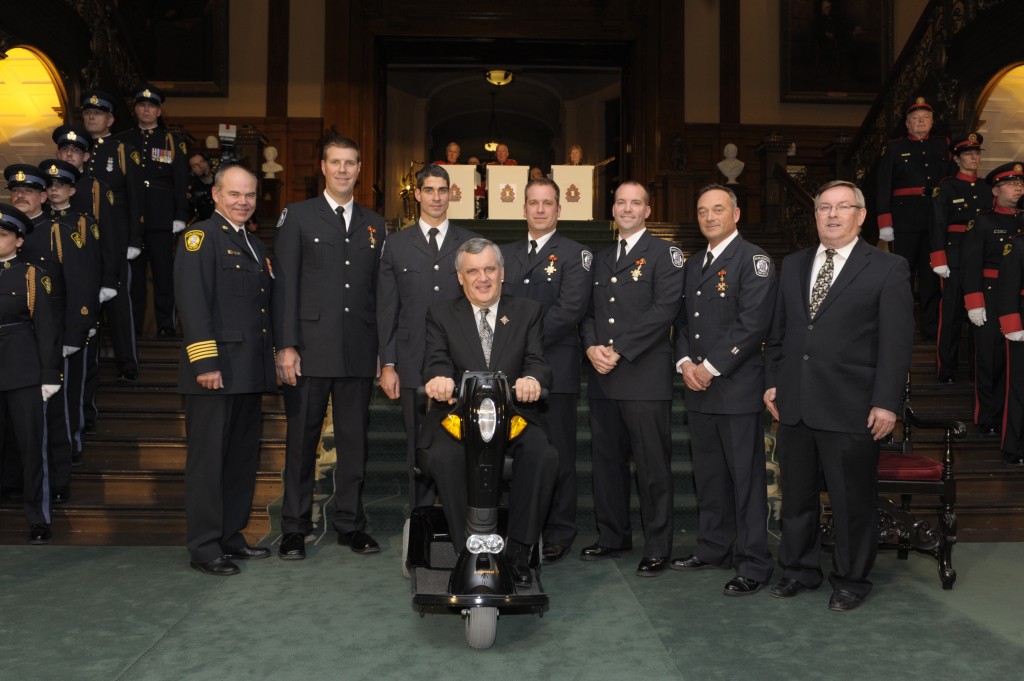 These Burlington fire fighters were recognized by the province for their bravery and excellent work. 
 By Pepper Parr By Pepper Parr
BURLINGTON, ON. January 21, 2012 Well you have to give them some credit for having the temerity to ask the city for close to $1 million to tide them over until we get into an election year when all hell will break loose over just how much the Performing Arts Centre has cost the city so far.
The Burlington Performing Arts Centre (BPAC) is asking the city for the $637,310 operating grant is usually gets.
It then wants the city to cover the $225,250 shortfall from last year.
Then add in $68,100 for a full-time technician and $63,600 for a full-time sales associate.
Those add up to $994,260 which is as close to a cool million as you can get when you have your hand out.
Can we expect these two additional staff members to require funding every year as things go forward?
While the Burlington Theatre Board, that group that oversees the Performing Arts Centre, will offer a justification for the amount they are requesting – one hopes that the council committee that will hear this request requires every blessed member of that board to be present in Council Chambers, the bald fact is that BPAC hasn’t figured out what it has to do to make the venue viable.
Their solution seems to be – just ask for more money. The Mayor who sits on the Board seems prepared to go along with the request.
Just so we are sure who to watch for in the room – the members of the Board, based on the most recent information we have, are: Allan Pearson, Chairman; Rick Burgess, Vice-Chair; Peter Ashmore; Robert Ban; Councillor Rick Craven; Ilene Elkaim; Jeff Fielding, City Manager; Mayor Rick Goldring and Denise Walker
You know for certain that if the Performing Arts Centre had a surplus to show for the 2012 fiscal year they would all be sitting there in their finest preparing to take their bows and accept the kudos of a grateful city.
Do we have artists trying to do accounting? It will be interesting to hear what the Performing Arts people have to say when they explain the need for additional funds. The city’s approach to budget development now is to require a Business Case for every increase in funding. In the document that council members now have BPAC sets out the base budget contribution as
$1,014,100 in 2014;
$1,034,400 in 2015 and
$1,055,100 for 2016
The base contribution just keeps inching higher and higher. The public wasn’t told to expect this when they bought into the project. It’s too late now to go back – the building is up and operational – the question now is – can we afford what we have? Are we doing this the right way? Are the right people in place?
BPAC staff are predicting that attendance from the 2013 – 73,000 will rise to 90,000 in 2013 and 96,000 in 2014.
And that ticket revenue will climb from the 2012 $549,450 to 656,000 in 2013 and $669,100 in 2014
Advertising, sponsorship and fund-raising will go from the 2012 – $250,000 to $260,000 in 2013 and 265,200 in 2014. These numbers appear to have some reasonableness in them.
Rental revenue is predicted to climb from the $280,000 in 2012 to $368,675 in 2013 and then to $376,000 in 2014. Given the difficulty with rentals to date these numbers just might have been written by an accountant whose fingers were crossed.
Everyone wants the Performing Arts Centre to succeed. But wishful thinking serves no one – we need a Centre management that tells city council what they need to hear and not what they think council would like to here.
BPAC has a bit of an operating surplus – require them to use that and if they still don’t have what they need to meet the payroll – welcome to the real world. Reduce costs. The Business case suggested that not implementing the additions might result in mice – call the Humane Society and get a couple of cats.
Sometime in the summer a piece of public art will get placed just outside the building. If what we’re being told is true – it has the potential to be quite something – but is the public going to fully appreciate what Dan Lawrie has chosen to put $37,000 into or will it become part of a joke that is attached to a building we can’t afford.
Burlington needs what the building is all about – but Burlington also needs efficiency and prudence with what public money is spent on. Have we not learned the pier lesson yet?
Last time around, in 2012 when Executive Director Brenda Heatherington was asking for $624,814 she told a council committee that they were able to balance their 2011 $1.65 million budget.
Ward 3 Councillor John Taylor responded – “that’s music to my ears” and went on to add that “If you do that this year, you will have exceeded my expectations.” Expect the sound of clashing symbols and beating drums from Taylor, who has never felt the place would pay for itself, when the request to cover the 2012 shortfall gets discussed at council committee the week of February 4th.
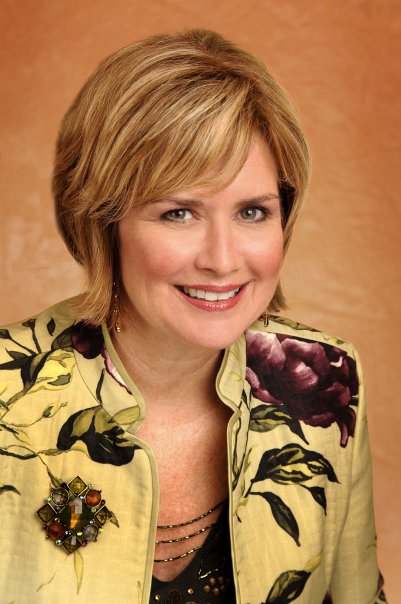 Councillor Lancaster will bring more than a pretty face to the budget committee meting when BPAC explains why they need the cool million they are asking for. Lancaster didn’t think the city was getting value for the $71,000 the Centre wanted in 2012 to hire a fund-raising person. At the 2012 meeting Councillor Lancaster questioned a sum of $71,000 + for someone to do fund-raising and sponsorships with the hope that $90,000 would be raised. Lancaster said that her experience was the fund-raiser would bring in two to three times more than they cost.
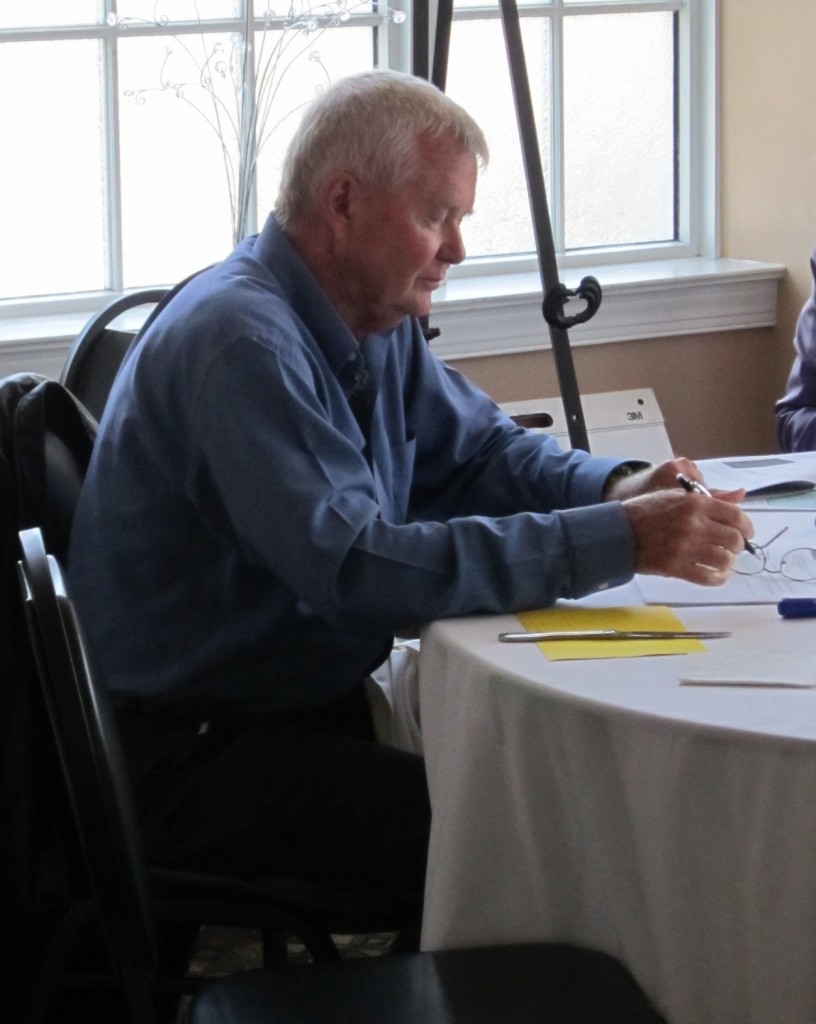 Ward 4 Councillor Jack Dennison not only does his homework but he tends to be the most direct when it comes to asking the hard questions. Expect him to bring a bit of a hard edge to the discussion over the close to $1 million BPAC wants for 2013. Councillor Dennison, who is always tough on the spending side, wanted to know how the BPAC people managed not to include the parking levy, the need for a janitor, the need for someone to clean the plate-glass in their staffing model. He also wanted to know why they didn’t see the need for a ‘development associate’ “How did we miss these?, he asked in 2012.
“We had a staffing model set up and that was the staffing model you said you needed and now you’re back looking for additional staff,” he said.
Heatherington explained that “you start a business with the staff you think you need to operate . She added “they anticipated adding a position for 2012”.
BPAC projected sponsorship, advertising and fundraising to bring in $250,000 in 2012 – that didn’t happen.
Councillor Dennison commented on the number of “dark nights” which were explained away as staff using the holiday time last year to recover from a very hectic opening schedule.
The BPAC opening events were great. The McLaughlin Gala cost a fortune but most of the cost was covered by the $400 admission price – to which all the tickets were not sold. Some had to be given away to fill all the seats. The Centre and its staff along with the Board were on a bit of a well-earned high.
That allowed them to get what they asked for in 2012 –it will be a different conversation this year.
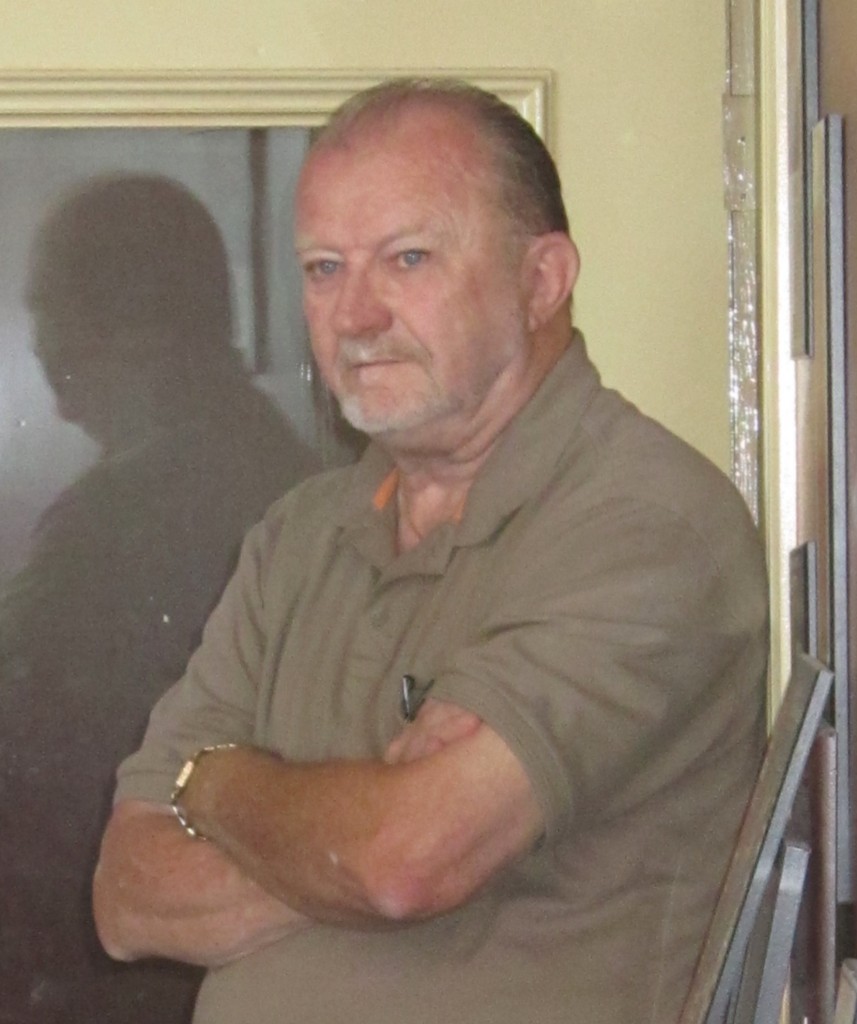 Keith Strong, the guy that muscled the building of the BPAC and ensured that it came in on time and on budget. Could have been chair of the Theatre Board – he’d earned it. He almost single-handedly ensured that Jane McKenna got nominated and then elected at the city’s MPP. Can he work some of that tough guy stuff on BPAC’s financial practices? Building the Performing Arts Centre came to $41 million. A very large part of that cost was raised by the team of people who promoted the idea, raised the funds, oversaw the project and ensured that it came in on time and on budget. Keith Strong headed up that effort.
The city provided $743,500 in funding in 2011, came back in 2012 to ask for $490,314 – which they said then they needed to cover ongoing program changes for $134,500, which includes $71,200 for a development associate position and $63,300 for building maintenance costs and payment of BPAC’s downtown parking levy. The parking levy was a contentious issue between the city and the Burlington Theatre Board who at the time didn’t realize everyone in the downtown core paid a parking levy. In this case it really amount to BPAC asking for money to pay the parking levy and then giving it back to the city to pay the parking levy.
The 2012 BPAC budget was $2,864,000 of which the city was asked to kick in $624,814. That year the city put up 22% of the money needed to run the place.
The 2013 budget is $2,938,165 with the ask amounting to $994,260 – which amounts to 34% . And these guys don’t pay rent for the space they use.
Mayor Rick Goldring defended BPAC during the 2012 budget debates. At the time he said: “This is a first-year operation and we want to make sure we create every opportunity for the board and the staff to succeed and I suggest we get out of the way and let them do their job.”
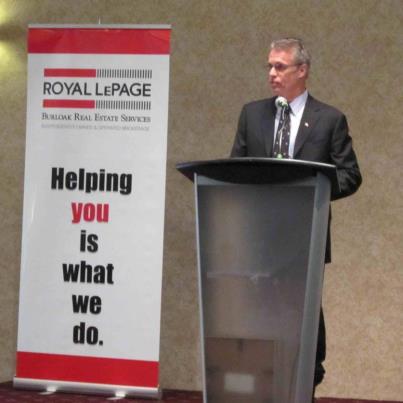 Mayor Goldring is a tireless advocate for the city. He is out at every event he gets an invitation to attend talking up the city. That’s part of the job – the harder part is bearing down on small problems before they become big problems – and the BPAC funding request is about to become a big problem. That was in 2012 – in 2013 the Mayor is reported to have said: “The reality is this is a new business and it just completed its first full year of operation and it is going to take maybe three years to find the right balance in the community in terms of what Burlington is looking for as far as entertainment and culture,” said Mayor Rick Goldring, who sits on the theatre board. “Also, it is going to take some time to generate additional rental revenues and reach out to the community and beyond to fill in additional dates.”
Different tone between 2012 and 2013.
Ward 2 Councillor Meed Ward didn’t support all of the 2012 budget request. Both she and Councillor Dennison moved that portions of the funding request be struck but both were voted down by a majority of council.
We’ve not had a chance to talk to Councillors Craven and Meed Ward.
Heatherington said BPAC would make an effort to find more sources of funding in future. BPAC got a pass in 2012 – they aren’t going to be as fortunate in 2013.
At some point the Theatre board is going to have to introduce a dose of reality into the way they are funded. That may take ‘three to four years’. Council can introduce that reality this year by doing their homework, reading the reports and pouring over the numbers. Their job is not to micro- manage but someone has to look at the problem – the Theatre Board certainly isn’t.
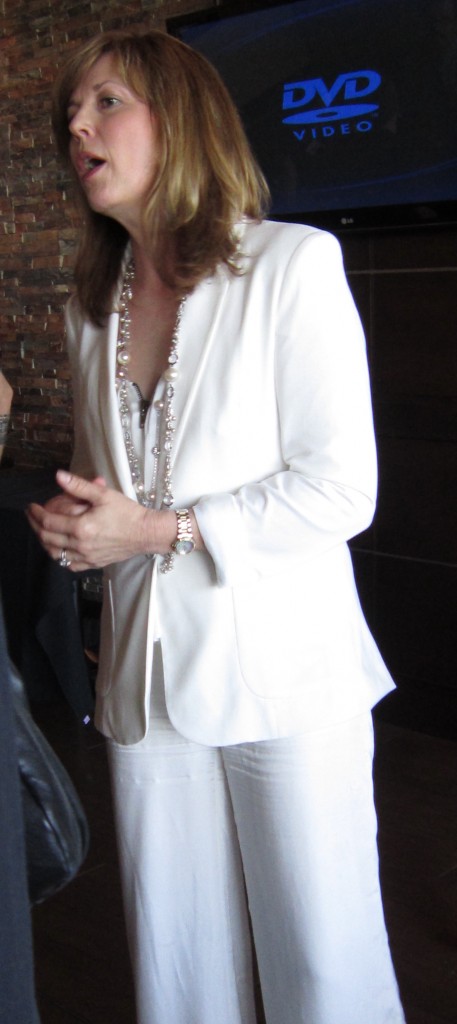 Brenda Heatherington brought a sterling resume to her interview. She had the reputation and the experience Burlington felt it needed. Her experience in Alberta has the potential to make BPAC a great place. However, she may need some help with the financial management side. Heatherington came to Burlington with a very impressive resume. The city took to her and loved the way she bought into the dream. No one knows better than Heatherington just how hard it is to get something like a Performing Arts centre off the ground. It takes time – and the city has given her some time – she now wants more.
They have missed their targets on rentals to the community despite calling everyone in business who has a telephone and following up on those that expressed even a hint of being interested. Was the rental projection too optimistic? Or was the person doing the selling not good enough? We don’t know.
Sponsorships ad grants have not materialized. Were the projections unrealistic or did the financial landscape change. We don’t know.
Who buys tickets to events? Does BPAC have that data? If they do – they’re keeping it under their skirts. When you need financial counseling – and a short fall of $225,000 plus means you need financial counseling – then you open the books and get the help you need.
Has the Board issued a statement on the condition of the organization they oversee? We’ve not seen one but then we don’t get press releases from BPAC; haven’t had one since we did a piece they didn’t like back in 2011. Before that piece we had one senior member of BPAC staff saying we were the “best thing that has happened to Burlington in a long time”. We said the Board was irresponsible then – looks as if they are still irresponsible.
Being a member of the Theatre Board is not a social plum; it is the recognition by the community that we believe the men and woman chosen are capable of identifying the problems when there are problems and then taking the necessary steps to resolve the problems. We call that good governance.
On two occasions that I can recall while sitting through council committee meetings I have heard city manager Jeff Fielding apologize twice for mistakes that were made. One of them wasn’t a mistake he made but he apologized nevertheless. Brenda Heatherington might be well served by going to the city website and watching a responsible manager do what has to be done – manage openly.
BPAC has indicated they expect to need more than was planned for the next number of years. This is the time to ask the hard questions.

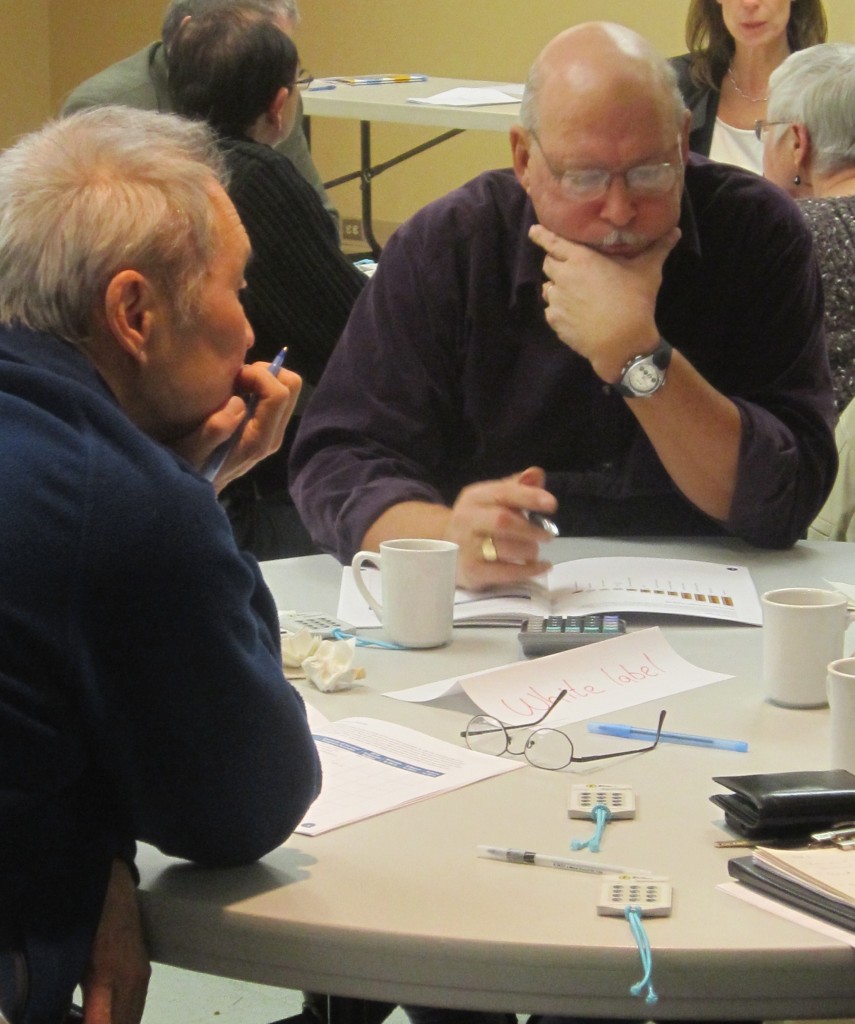 When citizens, be they people involved in non-profit organizations or on civic committees get together – things happen. The Region is sponsoring an event that will pull together all the non-profits to Talk and Connect. 
By Pepper Parr
BURLINGTON, ON January 17, 2012 The Region of Halton is going to host networking series for non-profit sector to create opportunities for conversation, networking and learning to strengthen relationships within the non-profit sector.
The “Let’s Talk…Let’s Connect” series starts Wednesday, February 13, 2013 with a session facilitated by Paul Born, president of Tamarack: An Institute for Community Engagement and author of Community Conversations.
The session takes place from 9 a.m. to 12 p.m. (registration and light breakfast starts at 8:30 a.m.) at the Milton Sports Dome (605 Santa Maria Boulevard, Milton).
“Through many different initiatives, Halton Region regularly partners with the non-profit sector,” said Regional Chair Gary Carr. ”As part of our commitment to working with the sector, we are bringing people together to build strength in the non-profit sector to achieve their organizational goals. Building “capacity” supports the sector to manage services now and in the future.”
That “capacity” words might be working at the Regional level but Burlington is struggling with just what it means as it works it’s way through the creation of an Engagement Charter between the city and its citizens.
Building capacity in the non-profit sector is an action in the Citizen’s Priorities – Halton Region’s Action Plan for 2011 – 2014.
The “Let’s Talk…Let’s Connect” series seeks to connect people and ignite conversations about opportunities for collaboration that will help the sector achieve its goals. Paul Born’s session on February 13 will explore the power of multi-sector conversations for creating social and economic change in Halton. Participants will hear about Halton initiatives that began as conversations and are currently creating change in our community. The session is a great opportunity to share ideas, resources and discuss current trends.
All sectors are invited to participate in this networking series. Government, the non-profit sector, the private sector and funders can all make important contributions to these conversations.
To register for the first session or to learn more about the series please dial 311 or register online.
Sessions two and three for “Let’s Talk…Let’s Connect” will take place in June and October 2013. Topics will be determined based on discussions at the first session.

 By Pepper Parr By Pepper Parr
BURLINGTON, ON. January 16, 2013 While the part of Lakeshore Road that has the heavy traffic, and on which the city wants to paint lanes for exclusive bicycle use, is not in Ward 1, Councillor Craven assured a Workshop talking about how to better engage the community, – that there will be letters galore on how stupid an idea bike lanes on Lakeshore is. A view we must add which the Councillor does not share.
The different views on bike lanes on Lakeshore Road got trotted out at a four-hour meeting Monday evening at which council heard 12 delegations that basically broke into two camps – those who believe fervently that we will be healthier and the environment will survive if we can get cars off the road and those that believe they have the right to make left hand turns off Lakeshore into their driveways.
Issues like this are the bane of every politician – they can’t win. At least half of their constituents are going to be unhappy. This is the time when the politicians have to rise above their local interests and go for the better good. And on Monday night – they, for the most part, did just that.
It would have been one of those 4-3 votes that used to plague Burlington but with Councillor Taylor away it came in at 4-2 with Councillors Meed Ward and Sharman voting against the six to nine month pilot project city staff has proposed.
While there were solid arguments from intelligent people on both sides what was evident was the split in thinking. Great idea said Councillor Meed Ward – just not on Lakeshore Road,
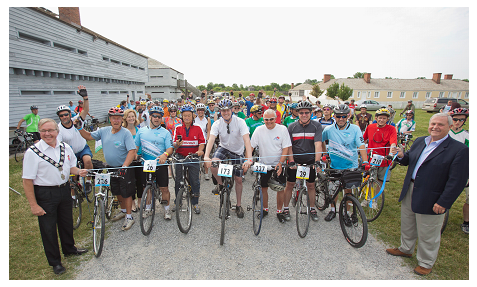 Ward 4 Councillor Jack Dennison, the only one without a helmet, doesn’t that tell you something, is an avid cyclist who has put his money where his mouth is. His popularity will be tested when the lines get painted on Lakeshore Road. Jack Dennison, who lives on Lakeshore Road and is the Councillor for that part of the city explained very carefully that this was just a pilot project, but the intention is to eventually provide bike lanes for the full length of Lakeshore Road – from the canal on the west end all the way to the Oakville border.
The cyclists and the environmentalists believe the time has come to take serious steps to lessen car use and Monday evening they got past the first hurdle. Council committee instructed the Director of Transportation Services to conduct a trial re-marking of Lakeshore Road between east of Seneca Avenue and Guelph Line to provide on the road bike lanes and to report back to Council in the Spring of 2014 on the results of the pilot.
There are some complications in that the Region is digging up part of the road and exactly when that work will be completed isn’t certain. When you dig a hole in the ground to get at a water pipe – you never know what you are going to run up against – so timing gets a little iffy.
Some of the residents along Lakeshore brought good arguments to the table – but nothing they said was reason enough not to do a pilot. Right now all we have are a lot of strong feelings on both sides. Some data will help.
The city ran into the same problem when it put in the bicycle lanes on Walkers Line and Appleby Line south of New Street. The world was going to end – but it didn’t. There haven’t been any problems – however, there hasn’t been a huge increase in bicycle use along those stretches of road either.
Does it need more time for the city to know if the Appleby and Walkers bike lanes were a good idea that is being used by citizens? Probably too early to tell and it will take some time to learn if the volume of traffic on Lakeshore Road can accommodate bike lanes on the north and south side of the road, and if it is truly safe as well?
The cyclists believe it can be made safe while the people who live along the road or adjacent to it can only see long lines of cars backed up while someone waits to make the left hand turn into the street they live on or their driveway.
Jim Barnett, who lives on Shoreacres said that he has faced occasions where he has had to wait for more than five minutes before there was a chance to gun his engine and slip across the oncoming traffic. Dr. Margarett Ackerman spoke for herself and a number of residents and said that it was always very difficult to make the left hand turn into her hone when she was returning from the Joseph Brant Memorial Hospital where she is an emergency surgeon and told of a situation when an obstetrician was not able to get to the hospital on time to handle a delivery.
Mention was made of back-ups that are 50 cars in length that sit waiting for the person at the front of the line to be able to make that left hand turn.
There were exaggerations all over the place. Ken Love, the first person to speak spoke of the damage that cars do to our individual health and the environment; but what he had to say and his bombastic approach was so far over the top that he didn’t do much to advance the argument for adding bike lanes anywhere in the city.
 One of the few occasions you will see Councillor Meed Ward or Mayor Goldring on a bike. Councillor Dennison bikes, roller blades – big on physical stuff. Photo op promoting the two Car Free Sundays Burlington held in 2012 Councillor Sharman spoke of his concern for some of his elderly residents in Ward 5, who might die while in an ambulance that got tied up in traffic.
Meed Ward said bike lanes were a good idea – just not on Lakeshore Road. New Street or Fairview was her choice for bike lanes. Meed Ward does not use a bicycle.
It was hard to tell, while listening to the delegations, which way this council was going to vote. The Mayor will usually always side with the environmentalists – but you only see him on a bike during a photo-op.
Councillor Craven surprised us when he voted for the pilot project as did Councillor Lancaster when she voted to try it. Lancaster tends to identify with the hard-core Tory crowd along the Lakeshore and doesn’t usually go out on a limb. Her vote was the one that made the difference. Councillor Taylor was not able to attend the council committee but made it known that he did not support the pilot.
Dennison, a very active cyclist, takes the view that car drivers do not own the road – the road is there to be shared by cyclists and car drivers.
The bicycle crowd put forward some pretty solid data and they brought forward enough good argument to make the trial worth talking a chance on.
The issue for the cyclists is “quality of life”. They know that Burlington is not going to be like our sister city Apeldoorn, in Holland, where a very large part of the population does not use or own a vehicle – Apeldoorn is basically the same size as Burlington and about as far away from Amsterdam as we are from Toronto.
The Dutch will be in Burlington sometime in the not too distant future to open up a commemorative park – might be a good idea to put them all on bicycles and listen to what they have to say about bicycle use in a municipal setting.
The cyclists believe that if you build it they will come. Which is just what the Lakeshore resident fear – that the cyclists will come and muck up the flow of traffic, making it worse than it is now.
“If you add bike lanes more people bike; cyclists go out of their way to use bike lanes.” That kind of statement sends shudders along the spines of those who live along the Lakeshore.
“We are all much healthier if we bike and get the exercise we need,” say the cyclists. “We agree” say the Lakeshore residents “and the city has all kinds of bike trails where you can do just that”.
 Who uses a bike in Burlington? There are the Strong and fearless (1%) – you see them on the road in the middle of winter. There are the enthused and confident; people who use their bikes frequently and would like to use them more – 5-10% of the cycle crowd. Then there are the no way, no how people, you will never see them on a bike, they make up 30% of the demographic. It is the 60% who are interested in using a bike but concerned about their personal safety. This is the target market and these are the people the cycling committees want to see on Lakeshore Road. The bike people want less hysteria, more facts and measurements. They would like to see the left hand delays measured; they want to know just how many bike car accidents there have been as well. During the Council committee the audience was told that there had been four accidents involving bikes over the last four years in the stretch of the road where the pilot is to take place.
Councillor Sharman, who is strong on data, gave Vito Tolone, one of the city’s traffic experts, a very tough time over the lack of data. Tolone didn’t deserve the punching around he got; there was no need to manage him quite as aggressively. It’s an approach Sharman chooses frequently – one hopes that when the data is available he will make good use of it and not exploit it shamelessly to convince his constituents that he is doing a good job on their on their behalf.
Lakeshore Road is between 9.6 and 9.75 metres wide from Seneca to Guelph Line. It widens to more than 10 metres east of Guelph.
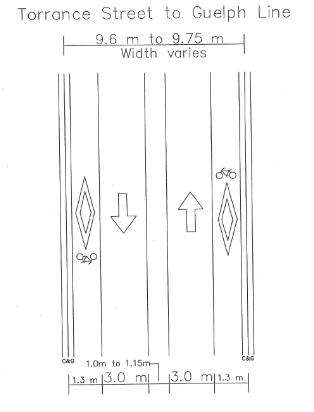 The pilot will run from SENECA, not Torrance, east to Guelph Line. The pilot plan is to reconfigure the road and mark it so that there is a bike lane on each side that will measure 1.3 metres in width. There will be two traffic lanes 3 metres in width. These two traffic lanes will be separated by a lane – NOT a turning lane – that will be between 1 and 1.15 metres wide. It is a lane that cars can edge into when they want to make a left hand turn.
Can it work? We won’t know until we try. Will traffic still back up? Of course, we’ve done nothing to decrease the amount of traffic on the road. That’s a traffic engineering problem; a traffic management task – bicycles are not going to make a difference to the number of cars on the road. The proposed plan will reduce that turning lane and that might result in a line of cars building up behind the car that is trying to make the left hand turn. If the turning lane were made 5 metres wide – it still would not change the volume of traffic nor would it allow cars to make left hand turns any faster.
Those arguing against the creation of dedicated bicycle lanes are not looking at the bigger picture – which is to reduce the number of cars on the road.
The bicycle people argue that the world has changed in 20 years and that the youth of today are not jumping into cars the way previous generations did. They point to a study that has younger people not buying cars and that demand will be down by 2 million units a year.
They point to data that has the percentage of 20-to-24-year-olds with driver’s licenses at 92 % in 1983 but currently at 81%; that could well be because this demographic can’t get jobs and have too much student debt to manage –but the fact appears to be that there are more younger people who have chosen not to drive a car.
The right decision, say the cyclists, is to widen Lakeshore Road – that option has a $9 + million price tag attached to it – which is half what the pier is going to cost us.
The next best, from the cyclists point of view, is to add segregated bike lanes to the existing road.
Burlington created two Car Free Sundays last year. The one on Appleby Line was successful but the one on Brant Street was close to a disaster.
Nevertheless, there is a core commitment on the part of this city council to get more people on their bikes. The pilot made it past the council committee stage. Council member phones will be ringing; the emails will flood the in boxes of every council member. Will they stand their ground or will they buckle – they are politicians. The ones to watch are the Mayor and Councillor Lancaster. We just may see what they are really made of.
Why is traffic on Lakeshore such a mess? Where do the cars come from and is there anything that can be done to divert traffic? If one wonders what traffic on the QEW is like all you have to do is check out the flow along Lakeshore. When the QEW is basically “stop and go” in spurts at that – traffic will cut south to Lakeshore where there is at least some movement. Is there some way to keep the traffic on the QEW and prevent it from drifting south the Lakeshore? That’s something traffic engineers have to work out.
 Concrete poured when the road was upgraded in the mid ’30’s. Known then as The King’s Highway it was THE route from Toronto to Niagara Falls. Lakeshore Road was originally known as the King’s Highway – Hwy #2 to many people. Construction began in 1917. In the mid 30’s the road went through a significant re-build. It is now a nice easy road through perhaps 50 communities between Windsor and Gananoque.
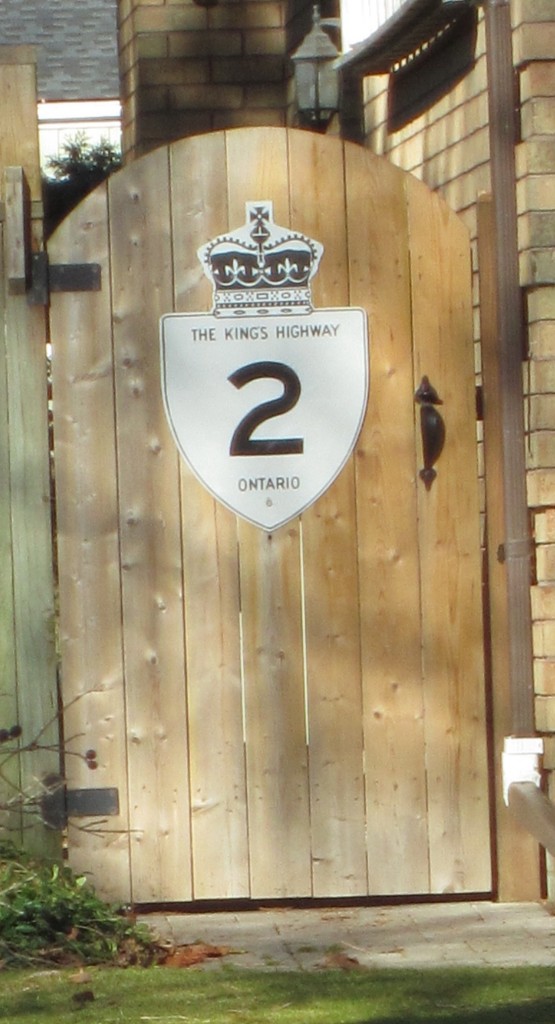 The old Highway name is now a decorative item for one of the homes along Lakeshore Road. What it becomes in the next 25 years will be at least as interesting as the last 25 years. It’s no longer a major highway. It many small towns it runs along the main street; in places like Burlington it is a road that could, if we let it meander along the edge of the lake where some magnificent homes have been built. It’s a wonderful drive through smaller, picturesque communities. We seem to have forgotten that in Burlington and see it as a road we should be able to zip along and at the same time treat as a street where we can turn into our driveway and not have to wait more than 10 seconds.
Change does not come about easily. For years most of us smoked; for years many of us never used the seat belt and for the longest time we felt it was OK to “have one for the road” and got behind the wheel of our cars when we really weren’t able to drive safely.
Times changed. Gas was cheap, we lived in sprawling suburbs where a car was vital – and they were fun to drive. You came of age when you had a car and the open road was all yours.
Now we are aging. For many that are in their 60’s their night-time vision isn’t what it used to be. Most of us know that there will come a time when our family doctors will have to tell the government we should not have a license. But we will be able to ride our bicycles for those small errands –and city council wants to have those safe cycle paths or lanes in place for that close upon us aging society to use.
Rob Narejko spoke to the Council committee as Chair of the Cycling Committee and said the information he was using was factual, with references to studies from accredited universities, government agencies who specialize in health and transportation. “You know my delegations are generally short and to the point”, said Narejko, “I regret, for both of us,” he added “that today’s delegation is much longer.”
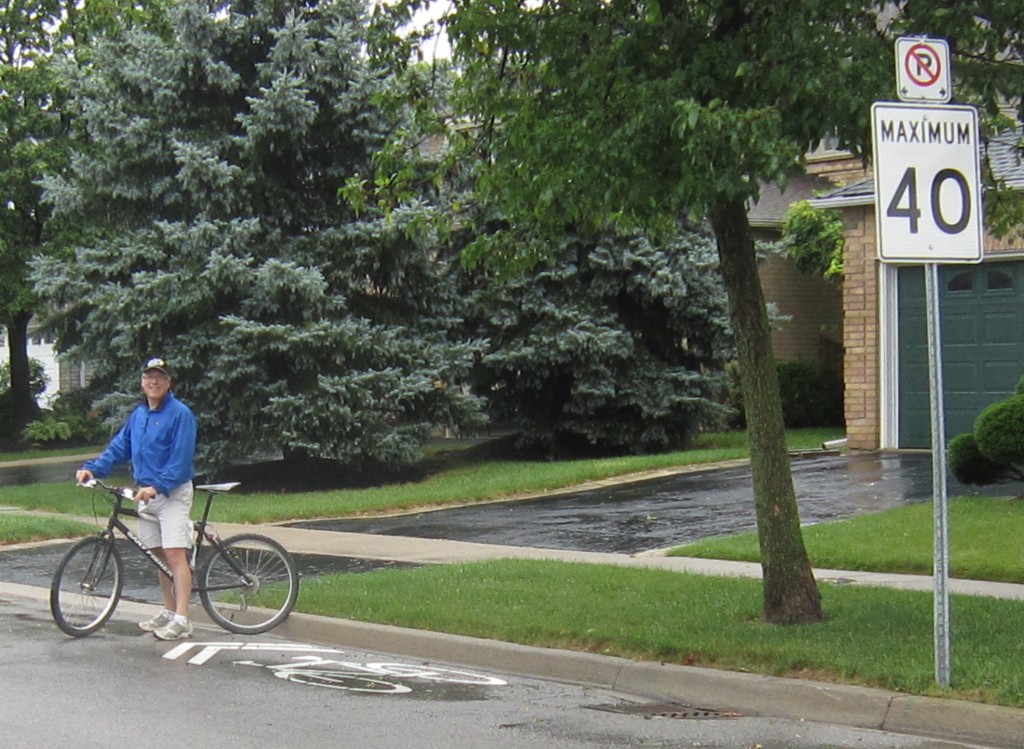 For Rob Narejko – this is the only way to go – slow speeds and roads with bike lanes. It is what he considers a quality life style. He drives a car as well. To put his remarks in context Narejko mentioned the value of strategy for continued viability of the City, the value of an active lifestyle and the value of the lines on the road.
“Nothing fails like success”, a quote attributed to many people and used by Narejko to show people have become comfortable with the way life is now. “They forget the work and tough decisions that got the city to where it is now and become complacent. The city gets stagnant, unable to attract business investment. Taxes rise, residents become disgruntled and before long, a once prosperous city is in decline” said Narejko.
Many people believe Burlington is a success. In this snapshot in time, it definitely is. But there are signs that show we are not keeping up.
Narejko pointed out that “Cars are a significant part of our city because we have designed our cities around the car. Cars are definitely needed as a method of transportation, due to the design of the city; just under 80% of people use their car for their daily trip to work.”
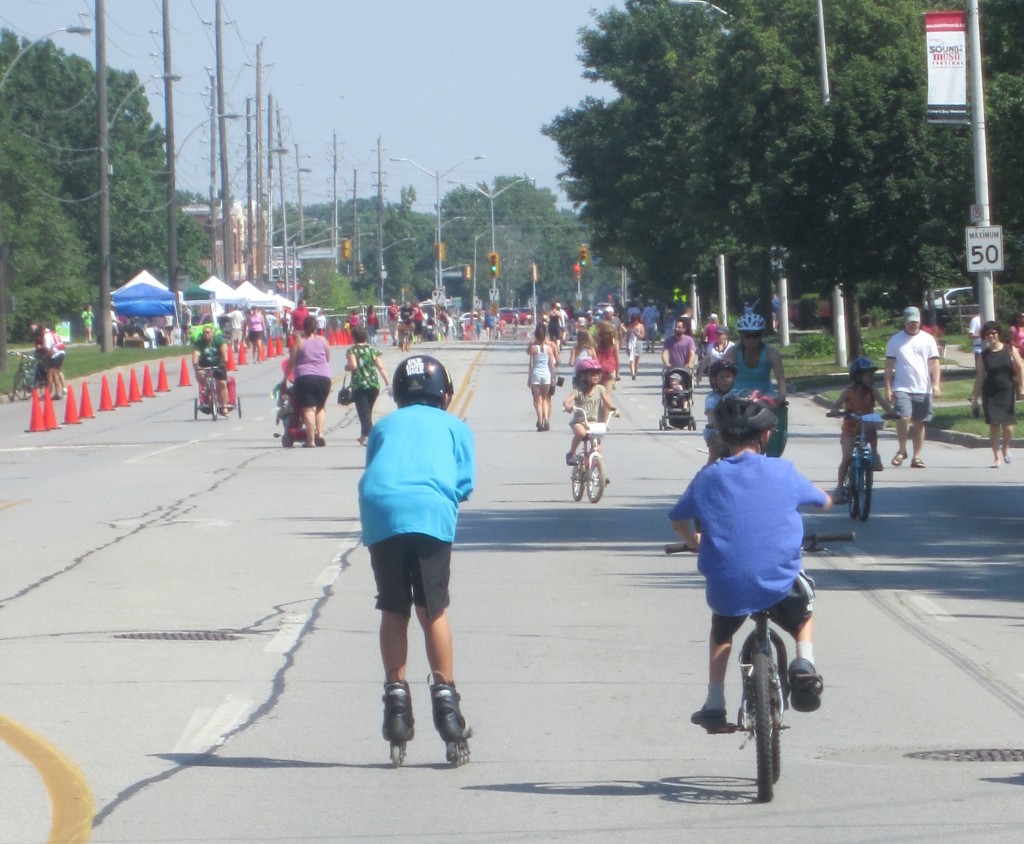 If it’s about “quality of life” this is probably what they are talking about. The Car Free Sunday on Appleby Line south of Fairview. One part of the city’s longer range project to get people using their bikes. “A city is about people: says Narejko. “People make the city work, not cars. Bikes, walking, public areas, green spaces are about people. It takes a crisis for most people to adopt change. Smart leaders don’t wait for a crisis. They create a vibrant plan for the future, through consultation with experts and the general public and then they carry through on that plan. If you don’t act on the plan, why go through the effort of creating them, taking up people’s time, spending money on experts and then shelving the reports? Do you want to be known as Councillors who kick the can down the road for the next Council to deal with when we are deep in trouble? Or do you want to be known as leaders who guided the City to the next level?
 Rob Narejko, Chair of the City’s Cycling Committee rides a bike, a motorcycle and drives a car. Does he ever take the bus? Rob Narejko maintains that Council was not elected to maintain the status quo. He isn’t going to get the level of agreement he expects with that argument – there are many, perhaps most people, in Burlington who are quite happy with the way things are – and they don’t want much in the way of change.
“Look at this issue” implores Narejko: “look at Guelph Line, Brant St, Walkers’ Line, Appleby line where changes were made: It is amazing to me how much people complain about minimal, positive change prior to it coming and then where do they go afterwards? Not a peep.”
“Has there been any negative feedback from any of the Guelph, Walker’s or Appleby projects? To my knowledge, gathered from City staff, no there have not.”
One of the dumber ideas Narejko suggested was that if traffic commute time is a priority on Lakeshore Road, then the city should pass a by-law that would permit only cars that belong to, and are driven by Lakeshore residents between the hours of 5:00 and 6:00 PM, Monday to Fridays. Narejko, who normally has useful argument, might want to pull that one.
Cycling, Narejko pointed out, is an accepted, legal and critical mode of transportation in all cities in all countries around the globe. He added that he could hear the nay-sayers piping up with: ‘yes, but not in Burlington’
Narejko and his colleagues point out that there are strategies developed by expert and rigorous processes to guide thinking at all levels of government which Burlington Council seems to ignore. There are five provincial initiatives (Places to Grow, Big Move, Strategic Cycling Plan (draft), Healthy Eating Active Living, Complete Streets) either in place or being developed as well as two Regional initiatives (Active Transportation Master Plan (under way), Active Halton) and then the city’s Cycling Master Plan and the Strategic Plan.
“It is very frustrating as an invested citizen in this community” said Narejko, “to have to fight for what should logically be done based on strategies and advice already in place.”
This initiative did get past a Council committee – all it has to do now is get through Council at the end of the month – without another dozen delegations please, and let’s get on with the six to nine month trial and see what the data tells us.
But it isn’t going to be quite that easy – is it?

 By Staff By Staff
BURLINGTON, ON January 16, 2013 Earlier in the week the Burlington detachment of the Halton Regional Police Service were made aware of a threat that had been posted on Facebook.
The threat involved a youth who had posted a picture of himself on Facebook holding a high-powered rifle with a caption uttering a threat towards another male.
 This is NOT the picture the police found on Facebook but it is the kind of thing that misguided young men mostly put on Facebook pages. Burlington police were able to apprehend an Oakville youth before the threat he had issued went any further. Police investigated and were able to determine where the photo had been taken which had members of the Burlington Criminal Investigation Bureau seize two shotguns, shotgun ammunition and the rifle depicted in the photo. The accused was located and arrested without incident.
A 17-year-old Oakville male whose identity is protected under the provisions of the Youth Criminal Justice Act has been charged with Utter Death Threat; Use Firearm in Commission of an Offence and Unauthorized Possession of a Firearm
 We all know where this picture was taken: Newton Connecticut where 20 elementary students were killed by a young man with a rifle. Has the American gun culture reached Halton Region? Threats of violence posted to social networking sites will be actively investigated by the Halton Regional Police Service in an effort to enhance community safety.
We tend to think this kind of stuff happens south of the border – it is happening here as well. Parents need to be vigilant.

 Burlington has engaged in the creation of an Engagement Charter, which was one of the recommendations in the 2010 Shape Burlington report. Burlington has engaged in the creation of an Engagement Charter, which was one of the recommendations in the 2010 Shape Burlington report.
The creation of the Charter has not been an easy task and the document has yet to be approved by Council and made city policy.
The document set out below is the second version of the Charter put forward by the Engagement Charter Team after considerable discussion with senior city hall staff.
This document is expected go through additional revision.
Burlington Community Engagement Charter – Version two
- 1. Introduction
The Burlington Community Engagement Charter is an agreement between and among the City of Burlington Council (City Council) and the citizens of Burlington concerning citizen engagement with city government. It establishes the commitments, responsibilities, and fundamental concepts of this relationship, based upon the City Council commitments set forth throughout this Charter.
This Charter’s overarching objective is to bring meaningful citizen contribution and insight to city decision-making by enhancing communications and access to information for citizens, and to facilitate and enable meaningful citizen engagement.
Details of the charter actions are presented in the Burlington Community Engagement Charter’s Action Plan and Staff Guide.
The Burlington Community Engagement Charter does not supersede existing laws, by-laws, statutes or acts.
3. Charter Vision and Mission Statement
Vision:
Burlington aspires to become increasingly more engaged and connected with its community.
Mission:
To provide Burlington citizens, members of City Council and City staff a plain language, living, policy and procedural document that guides and promotes active and meaningful citizen engagement in the City of Burlington’s planning, policy-setting and decision-making processes.
4. Burlington City Council Commitments:
To fulfill the vision and mission of the Burlington Community Engagement Charter, City Council makes the following commitments:
Accountability
The City of Burlington will be responsible to its stakeholders for decisions made and policies implemented, as well as its actions or inactions. [1]
Transparency
The City of Burlington will actively encourage and facilitate stakeholder participation and openness in its decision-making processes. Additionally, transparency means that the City of Burlington’s decision-making process is open and clear to the public.[2]
Early and Widespread Notification
The City of Burlington will provide early and widespread notification to citizens about proposed developments, policies, initiatives, and municipal projects.[3]
Delegation Process
The City of Burlington Council’s delegation process, which allows citizens to address Council and Standing Committees on issues, will be respectful and welcoming.[4]
Clear Language
The City of Burlington will use plain and clear language in documents and public communications that is more engaging and understandable for citizens than technical language and jargon.[5]
Openness and Access to Information
The City of Burlington will provide open data and information to the public in recognized and useable formats to facilitate healthy discussion of city issues. The City of Burlington will provide a variety of ways, including routinely available information in on-line formats, print material, and face-to-face opportunities for citizens, city staff and Members of Council to share information and, discuss ideas and options.
Community Feedback
The City of Burlington will inform citizens how their input was considered and used or why it was not used in City projects, initiatives and policy development.
Capacity Building
The City of Burlington will support citizens and community groups to develop their skills, ability, and confidence to participate effectively with respect to decisions that affect their community and lives. This support will involve education and information about City processes, initiatives, and policies, as well as supporting citizens’ ability to connect with other citizens on city issues.
Inclusivity and Accessibility
The City of Burlington’s public engagement processes will involve and enable the participation of the full range of its diverse population. [6]
Adequate Resourcing
The City of Burlington will provide adequate resources including staffing and budget to achieve the goals of the Burlington Community Engagement Charter and to implement and realize its recommendations.[7]
Measurement, Evaluation and Review
A public process will be established in which The City of Burlington will measure and periodically review the effectiveness of the Burlington Community Engagement Charter. Improvement based on the evaluation of the success of public involvement processes will ensure that the Charter is a “living document”.
Conflict Resolution
Regardless of the best intentions of all involved, conflict can arise in the course of an engagement process. Depending on the type of conflict and the issues involved, different resolution mechanisms will be appropriate. Conflict resolution is described in appendix “A”.
 6. Public Participation Spectrum: 6. Public Participation Spectrum:
Five levels of engagement, referenced from the IAP2’s Public[8] Participation Spectrum will be used in City of Burlington community engagement activities. A more complete description of the IAP Spectrum of Participation appears in appendix “B”.
7. Bringing Charter Commitments to Life
The Charter establishes important citizen engagement commitments by the Burlington City Council. This section summarizes City of Burlington practices and procedures to both define and implement those commitments and to bring to life citizen engagement.
Early and Widespread Notification:
The City of Burlington will have an early notification system that provides early information about planned policy development, projects, issues, meetings, and events. This system will include notice posted on the City website about topics to be considered by Standing Committees and City Council at least two months prior to the relevant meetings. The notice will include staff contact information for citizens who may have questions or wish to provide early input.
To ensure that notification is as widespread as possible, the City will use a multi-media approach including local print media, the City of Burlington website, other relevant websites, on-line digital communication, social media, as well as reaching out to groups that might have an interest or would be affected by decisions. The City of Burlington will establish a direct notification system to which citizens and groups can sign up for early notification through email, social media, or other means.
Staff Reports:
When citizens have been engaged on a city initiative; prior to submitting the staff report to committee or council for decision, staff will check with citizen participants to ensure the report accurately reflects citizen input. This is especially important for major issues and long-term planning, with the noted exception of the city’s development section of the Planning and Building department. Usually this will be done through a response summary document or report section.
Talking with Council – The Delegation Process:
The City will publish a document outlining the delegation process as a guide for citizens.
Staff Training and Performance:
Public engagement training will be provided to all staff who will be engaging
citizens to ensure consistency in the engagement process.
Community engagement practice will be reflected in staff performance expectations, and measured in the same way as performance of any staff core competency.
Communication and Outreach:
Relevant and important information will be available through the website and social media, making information accessible to citizens when they require it.
Making relevant information available in print form, including newspapers, the City Talk publication, and special mailings, remains of great importance for many citizens and stakeholders
Full use should be made of all available sources and reference copies should be available at city libraries and community centers.
Inclusivity and Accessibility:
Enabling participation requires removing barriers to enable citizen participation. Examples of enabling actions may include, but are not limited to, the following:
- Meeting the needs of persons with disabilities; the city relies on the City of Burlington Accessibility Advisory Committee; the Burlington Accessible Customer Service Guide: and the expert advice of City of Burlington Accessibility Coordinator. For more information on accessibility.
- Using language that has been verified as being clear/plain;
- prearranged, language translation; transportation; child care
- options for participating online/digitally
- Public involvement processes will consider ways to enable participation.
Citizen Advisory Committees:
Citizen Advisory Committees should provide both City Council and staff with a valuable array of experience, knowledge, skills, and community contacts, as well as being a source of informed advice on issues related to their Terms of Reference. For more information about Citizen Advisory Committees and enhancing their role and effectiveness, see appendix “C”.
Capacity Building:
Capacity building will focus on increasing the number of participants, the frequency of participation, and knowledge, ability and skills of those involved to meaningfully participate in engagement processes.
Budgeting / Resourcing:
The City of Burlington will support implementation of the Burlington Community Engagement Charter by providing sufficient resources to ensure its success. These resources include:
- Hiring of a full-time engagement coordinator at a senior level to manage the implementation and ongoing performance of the charter and related costs to support this function, and
- Providing resources to implement the actions in the charter’s section – Bringing the Commitments to Life, the charter’s outreach processes and the strategic actions described in the Burlington Community Engagement Charter’s Action Plan
Charter requirements will be met by city staff in their engagement work, and also by outside consultants or contractors hired by the city. Staff managing consultant-supported work will ensure that all external consultants are informed of Burlington’s engagement requirements and then advised on how to meet them. Advice will be provided by the city’s public involvement coordinator.
Measurement, Evaluation and Review:
Measurement and evaluation will comprise a two-step process. Each community engagement plan will set out: its objectives; the steps to reach those objectives; and, specific and objective measures to determine success. At the conclusion of each project, staff will prepare a brief evaluation report assessing to what degree the success measures were met. The public who have participated will be asked to provide their assessment of the engagement activities as they are delivered, and these views will also form part of each evaluation report.
Each City department and the Engagement Coordinator will share responsibility for reviewing these evaluation reports as part of the continuous improvement process and create best practices to be shared and shortcomings to be addressed on an ongoing basis.
Evolution: The Charter and its implementation will be reviewed every year in the first two years, then every two years thereafter. This second level review will assess overall compliance and results, how to better the practice of engagement management, and the relevance of new factors, such as changes in technology and demographics that may influence the practice of citizen engagement.
These reviews will seek input from citizens, staff and members of city council and may include peer review. A key action in delivering continuous improvement will flow from the feedback provided to the community. Anticipated improvements will include using new technologies, engagement methods, the growth of staff competency, and the increasing capacity and participation of Burlington’s citizens.
 The City will use a web-based reporting mechanism, similar to a report card, to inform the public of the City’s engagement performance in relation to the measures established by the Charter. Reporting will occur annually and the results will be posted to the City website. The City will use a web-based reporting mechanism, similar to a report card, to inform the public of the City’s engagement performance in relation to the measures established by the Charter. Reporting will occur annually and the results will be posted to the City website.
Version 1 of the Charter
[1] Definition from City Council Procedural By-law 93-2010
[2] Definition from City Council Procedural By-law 93-2010
[3] Based on the Shape Burlington Report, April 2010
[4] Based on the Shape Burlington Report, April 2010
[5] Based on the Shape Burlington Report, April 2010
[6] Based on the Shape Burlington Report, April 2010, and the Report of the Burlington Inclusivity Advisory Committee, June 2010
[7] Based on the Shape Burlington Report, April, 2010
[8] Note: The International Association for Public Participation (IAP2) uses the term ‘public’ to refer to what the charter calls citizens, ‘community’ or ‘stakeholders’.

 By Pepper Parr By Pepper Parr
BURLINGTON, ON January 15, 2013 This is the time of year when your council members gather around the table they call the horse shoe and figure out how much of your money they need to run the city.
This Council committed themselves to a 10% increase during their four-year mandate. Staff has come forward with a budget that calls for 2.3% this year – but that is just for starters.
Because taxes and elections go hand in hand Councillor Meed Ward let it be known that she kind of liked a 1.85%increase.
City Manager Jeff Fielding explained to the Council he serves that he was hoping the city would accept the 2.3% and work with him on what are being referred to as the growth items – that is things people want money spent on that are growth items.
Sound of Music will be coming to the trough asking for more money to grow their event. The rules at city hall are in the process of changing and anyone, who wants additional money or new money, has to make a Business Case that gets reviewed by the city’s Executive Budget Committee (EBC) but not necessarily recommended by that committee.
Fielding wants Council to make these decisions. He wants his people to look at the case, but not make it something city staff is advocating.
With a Staff recommendation attached to an additional expense, council members can point to staff and say ‘this was their idea’. Fielding is the kind of city manager, who once said to this council: “Do your jobs” and he expects to keep their feet to the flames.
If there are tax increases it will be because city council decided to spend money – the buck stops right in front of the council members. That will make for some squeamishness on the part of those council members who are, how do we put this, “at risk” of losing their council seats.
The city has just begun the budget debate process. There is one critical date for the public and that is a Public Meeting to take place January 30th at the Burlington Art Centre at 7:00 pm.
One does have to ask: Why are these events always downtown? Why do the people in the Orchard or the newly opened Alton Village, never mind Headon or the other communities well north of the QEW have to trudge downtown every time. Admittedly, there isn’t much in the way of public space – the schools aren’t open in the evenings but surely there is a high school that has a gym that isn’t being used one night. For those of you in Wards 3 and 6 – bang away at your council member. Not at all sure why Councillor Craven doesn’t create a City Hall West (would he like to call it the West Wing?) and have the number crunchers trot out to Ward 1 and tell the budget story.
There is a lot more to the 2013 Budget – the binders for the Capital Budget and the Operational Budget were made available – one of the them is a couple of inches thick – need some time to pour through the numbers.
The city however doesn’t rely on staff to ensure that they don’t run out of cash. At the end of the Budget and Corporate Affairs Committee meeting council slid into full Council mode and passed a quickie “interim tax levy by-law” allowing them to send out a tax bill before the 2013 Budget is approved.
Wouldn’t the private sector love to be able to do something like that.

 Staff Staff
BURLINGTON, ON. January 14, 2013 The Mountain Grove – Guelph Line – Upper Middle Road part of town took a bit of a hit from the vandals over the weekend. Two stores were broken into along with an additional six stores elsewhere in the city.
Police investigate these crimes but they can’t be everywhere all the time. Solid policing happens when community co-operates with police – if you see something that doesn’t look quite right – it probably isn’t quite right.
Give the police a call – they have enough in the way of cars on the road to get to almost any place in a couple of zip zips.

 By Pepper Parr By Pepper Parr
BURLINGTON, ON January 14, 2013 They are back at their first Council Committee meeting and started out with the newly formulated Development and Infrastructure Committee which handles everything that the prodigious Scott Stewart produces. The agenda was so long that it has to be published in two parts and managed at two sessions; the first this afternoon and the second this evening.
Ward 1 Councillor Rick Craven chairs this one and is working towards having items that has direct impact on the public held at the evening session and other “stuff” held during the day. The intention is to give the people paying for this road show as much time as they need to speak their minds.
Council did not cover itself with glory this afternoon.
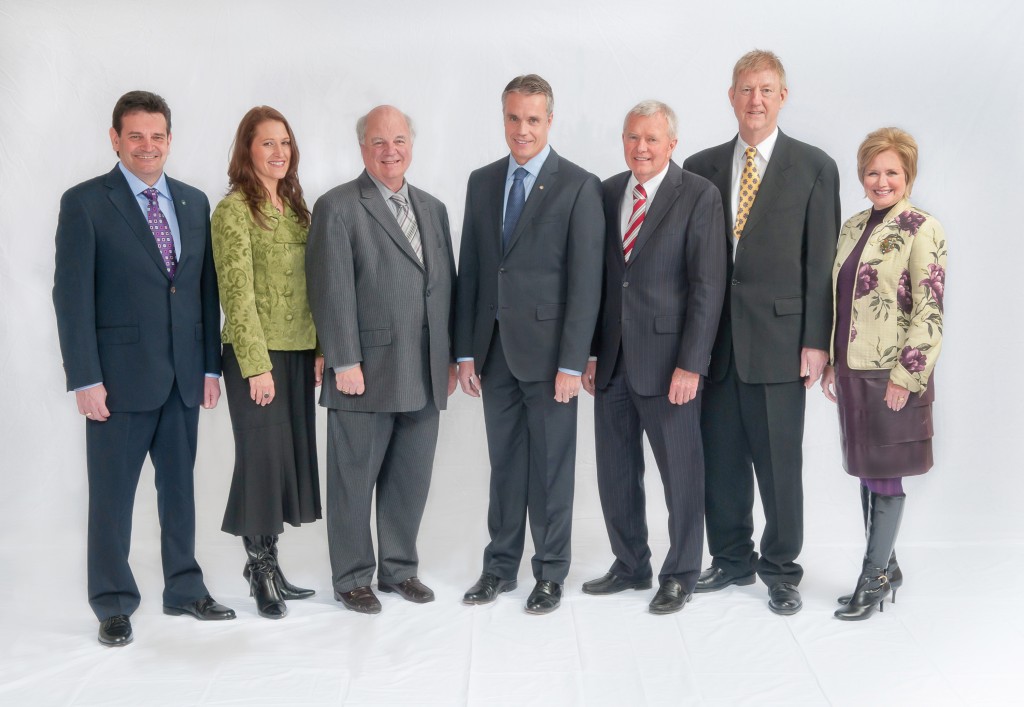 The significant seven, add in three lawyers, and you don’t get a pass on a smell test. Wonder what Councillor Taylor would have had to say had he been able to attend? At one point the Mayor slid out of his seat and tip-toed over to the city’s in-house legal counsel, Nancy Shea Nicol. Sometime after that Shea-Nicol tip toed up to the horse shoe and whispered in the ear of chair Craven.
Shortly after that the outside lawyer, the kind that earn enough to wear the $1,500 silk suits and the cashmere winter coats, along with Shea Nicol and Blake Hurley, the other in-house lawyer, all trooped to the horse shoe and went into a closed session of council.
What’s the big secret? Everyone knows the city is looking for a way to rezone land along the North Service Road between Walkers Line and Guelph Line, so that IKEA can buy the property and re-locate their store from Aldershot, where they appear to feel they have run out of space.
This city does not want to lose IKEA and it is apparently going to go through every hoop it can find to make that possible.
As one listened to the discussions this afternoon it was clear that there are some issues with the Planning Act and some of the Provincial Policies, which the city has to contend with. It was abundantly clear too that the city planner, Bruce Krushelnicki, is going to sign off on this one with his pen in one hand and the other holding his nose.
This is not going to be pretty.
They will be at it again this evening during which time it should be clearer as to just what it is they want to pull off.
One got the sense that everyone was standing in the foyer of a criminal court-house where people whispered to each other behind cupped hands.
There is a problem with getting IKEA into the site they want to buy and re-locate to, and that problems is not limited to just the rules and regulations they have to adhere to.
Drive along the section of North Service Road between Walkers Line and Guelph Line sometime and ask yourself if that road can handle the kind of traffic IKEA draws.
This problem needs much more serious thinking and if your planner isn’t 100% behind it – maybe it is time to take a pause. When you have to turn to the lawyer time and again – you know something just isn’t right. I think Burlington is better than this kind of approach. Someone needs to press the reset button.
Run that “second best city in Canada to live in” thing by me again!

 By Margaret Lindsay Holton By Margaret Lindsay Holton
BURLINGTON, ON. January 14, 2013 I have been watching and listening with a great deal of interest over the past few days to the ‘Idle No More’ movement that has erupted across Canada. There are many issues on the table, not the least of which is the desire by the people of the First Nations to be treated as Nations by the current Harper regime governing in Canada. In the midst of this activity – that had me thinking a lot about Canadian colonial history – I received a note from OurBurlington’s publisher, to remark on the recently announced winner of the Public Art Commission for the Burlington Performing Arts Centre. His note to me read, “Can you comment on this in your next column? Be fair, but be very direct as well”.
I read the attached press release. Peter Powning, from far-off New Brunswick, has won, with his design, Spiral Stela. Included in the City of Burlington’s press release was an open invitation to the public to add ‘objects of significance’ or “cultural mulch” to his sculpture. “The artist will make a mould of the object, which will then be cast in bronze and added to a large band that encircles the sculpture.” Three times and two locations were provided so the public can participate: Jan 31, 10-3 pm at the Central Library and 7 pm-9 pm at the Burlington Performing Arts Centre, and also February 3rd at the Burlington Arts Centre from 2-4 pm. The final session will include an artist lecture and ‘creating session’.
 The proposed sculpture: Spiral Stela, by Peter Powning, from far-off New Brunswick. Well, here’s my opinion about all that. (Remember I’ve just been listening, watching and learning from the Idle No More movement … )
I agree to participate in the ‘cultural mulch’ ceremony that will ‘imprint’ objects of significance – presumably from Burlingtonians – onto this foreign object, for posterity. To that end, I will bring a swatch of plastic grass to commemorate the winter of 2009 when our City Elders sold out a piece of our irrefutably unique natural heritage, now known as City View Park in North Burlington, at Kerns Road and Dundas Street, to the Pan Am Games organization of Toronto.
The DESIGN for this largest parkland area in Burlington, supposedly protected under the Greenbelt Act and the Niagara Escarpment Commission, was transformed in the 11th hour by City staff and members of our previous – and current – City Council into a ‘sports tourism destination’ without any public consultation with immediate residents, or an Environmental Impact Assessment that analyzes how tons of plastic grass will impact this environmentally sensitive era. Thems the facts.
Initially conceived as a “recreational” diverse ‘natural’ parkland area for ALL to enjoy, this park has – and will – become a ‘member’s only’ fenced-in facility geared towards ‘tournament grade’ soccer. In short, WE, the tax-paying public, have lost OUR park, an important local natural heritage ROOT.
There MAY be an opportunity to regain this park after the Pan Am Games in 2015 when the toxic artificial turf carpets must, by law, go to a hazardous waste facility. (Plastic grass expires every 5-8 years. Two of the plastic carpets were laid in 2011. The ‘tournament’ field and flood-lit stadium will be installed in the fall of this year, or spring of 2014. So, somewhere around 2020, that toxic gunk will have to come out.)
 City View Park: Before plastic grass installation, this once-living landscape had to be scraped ‘clean’ and made pan-cake flat. Photo by Margaret Lindsay Holton. At that time, it will be up to the NEW City Council to determine if taxpayers funds will be utilized to re-carpet this smothered ground again with million dollar plastic turf, OR, alternatively, whether they will finally have the good sense to rejuvenate this slowly dying eco-system with real growing grass, and, by so doing, provide an essential ‘natural habitat’ for animals (including humans), birds, insects and earth-churning worms. If so, they will also have the opportunity to remove the restrictive fences. This action alone would once again allow all forms of life to freely traverse across this unique open landscape. Living creatures could once again forage within this distinct portion of our section of the designated UNESCO Biosphere, known as the Niagara Escarpment.
Will they do it? Who knows.
Perhaps, years ahead, when Burlington has become the utopian Jersey Shore of the Golden Horseshoe, with electric light-rail transit zipping through the landscape powered by solar and geo-thermal energy, and the old-time ‘locals’ are long dead and buried, newly arrived residents will wonder aloud about the lunacy of previous City Elders who covered their ever-diminishing living-giving-breathing Earth with Life-defying plastic, especially in a ‘protected’ PARK. They may wonder why these turkeys so deliberately eliminated a vital and tangible connection to our communal Burlington natural heritage, the Niagara Escarpment. That is, of course, if they know how to wonder at all.
It is a very real possibility that this on-going eco-travesty will just be forgotten. Taxpayers will duly pay the exorbitant replacement costs for a PRIVATE ‘members-only’ tournament soccer facility in a PUBLIC park, and the wildlife that does still roam and roost throughout North Burlington’s escarpment terrain will just quietly die off … A dull robotic monoculture of humans will survive on imported genetically modified foods. Tax-enslaved workers will buy FRESH water from off-shore nations who did FIPA-like deals under Harper’s regime. Children will learn programming before they can speak. And ‘play’ itself will become a forgotten IDEA buried under intense competition to host tournament-sport ‘tourism’.
Still, I have hope.
On the first dawn of this New Year I looked out the frosted windows at the farm in North Burlington and watched as twelve robust wild turkeys emerged from a conifer stand and slowly began to forage across the snow-covered yard under the bright winter sun. It was a stately, near sacred, sight to see.
Where had they come from? Where were they going? And why did there seem to be so many?
I had to do some sleuthing.
 Author tracks multiple wild turkey tracks. Photo by Margaret Lindsay Holton. Wild turkey was originally native to Ontario, but they disappeared at the turn of the last century due to rapid colonization, habitat destruction and unregulated hunting by settlers. In brief, we killed off the species.
 But, in the mid 1980’s wild turkeys were re-introduced at 38 different release locations in southern Ontario through a program to “restore our natural heritage, provide fowl for hunting and viewing recreation, and derive economic benefits.” (Ministry of Natural Resources). Begun in 1984, the Ontario Federation of Anglers and Hunters, in partnership with the National Wild Turkey Federation and the Ontario Ministry of Natural Resources, launched a reintroduction program that began with just 274 birds. But, in the mid 1980’s wild turkeys were re-introduced at 38 different release locations in southern Ontario through a program to “restore our natural heritage, provide fowl for hunting and viewing recreation, and derive economic benefits.” (Ministry of Natural Resources). Begun in 1984, the Ontario Federation of Anglers and Hunters, in partnership with the National Wild Turkey Federation and the Ontario Ministry of Natural Resources, launched a reintroduction program that began with just 274 birds.
Stock from the wild turkey populations of New York, Michigan, Nebraska and Tennessee were often ‘swapped’ for wildlife species from this province: moose for Michigan, river otters to Missouri and Nebraska, and gray partridge to New York state. Today, wild turkeys have adapted to our agricultural farmlands totaling somewhere between 60 to 80,000 wild birds.
Turkey hunting season officially began in 1987, and was initially restricted to a spring hunt. But in 2009, a fall hunt was introduced. Only bearded toms, (mature male turkeys), are allowed to be harvested. ‘Turkey season’, (April 25th, after the peak breeding season, until the end of May), has now been established in most rural areas in Ontario. This hunt is also open to hunters from outside the province.
Wild turkeys are known as promiscuous breeders. Most individual adult males will mate with multiple females. Hens lay a clutch of 10-12 eggs during a two-week period, usually laying one egg per day. Young males are commonly called ‘jakes’ and young females are ‘jennies’. They consume a wide variety of wild foods, including hard mast (acorns, seeds), soft mast (wild grapes, raspberries), green vegetation, and insects. In areas where natural habitats have been replaced by agriculture, turkeys may also feed on domestic grains, like corn, buckwheat, alfalfa and/or soybean. Young turkeys (poults) feed almost exclusively on insects for the first several weeks of life. Insects provide poults with the high-protein diet that they require for rapid growth. A 2-3 week old turkey can eat several thousand insects a day. As you can see, wild turkeys, like all wild critters, need a diversified living habitat in order to survive.
 Wild birds die after ingesting bright bits of PLASTIC, mistaken as FOOD. Other predators, besides humans, such as coyote and raccoon, are capable of snatching young turkeys, but most are no match for a mature fighting tom. Wild turkeys can run up to 40 km per hour and fly as fast at 90 km per hour. They can cover over 20 miles per day in search of food. A male tom can be up to 4 feet tall (!), and weigh over 30 pounds. Females are, on average, about half that size. Wild turkeys have excellent vision during the day, but can hardly see at night. They roost high off the ground, usually in trees, at dusk. Conifers often provide thermal protection for roosting turkeys so they can conserve energy under extreme cold and windy conditions.
 Wild turkey roosting in trees at night fall. The sale of turkey licenses per annum contributes over $250,000 to wildlife management programs in Ontario. The annual spring and fall hunts generate economic activity for the province worth $2.3 million. (So says the Ministry of Natural Resources).
As of 1999, the use of live decoys, electronic calls and baiting for the purpose of hunting wild turkeys was prohibited. Finally, only a landowner, with a valid firearm license, may shoot wild turkeys that are damaging or about to damage their property.
 Obese domestically raised 20 pound turkey carcass in a kitchen sink. Can wild turkeys hurt you? Any wild animal when cornered or harassed may attack. So, if concerned, call in an expert. Note, only a registered turkey hunter or landowner (with a valid firearm license) can shoot wild turkeys.
All in all, the reintroduction of wild turkey in this province has been a success. Wild turkeys are thriving once again in Halton County in rural North Burlington. Due to human initiative and determination, this formerly extinct species has re-established a solid toe-hold in this, our home and native land. Their reintroduction has, as promised, added to the natural heritage of Ontario. The growing populations are providing viewing as well as hunting recreational activity and, as such, they are adding revenue to our economy.
If we, as humans, can do that over the short course of twenty odd years, surely we can a) improve our dialogue with Canada’s First Nations, and b) bring back City View Park to a ‘natural state’ for future generations.
I wonder what plastic grass looks like when it’s cast in bronze …
Margaret Lindsay Holton is both an environmentalist and a community activist. She is an artist of some renown and the designer of a typeface. She is also a photographer and the holder of opinions, which are her own, that she will share with you in an instant. She appears as an Our Burlington columnist every two weeks. All photographs are by MLH unless otherwise indicated.

 By Pepper Parr By Pepper Parr
BURLINGTON, ON. January 14, 2013 It took long enough, but the best of the three finalists in the most recent public art competition was announced today.
Peter Powning’s work, Spiral Stela, has been selected as the winning design for a public art installation at the Burlington Performing Arts Centre. Powning, of New Brunswick, was selected from a group of 119 artists from around the world who submitted designs for the project.
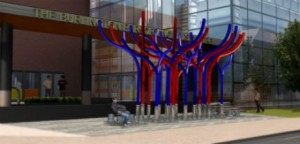 This Cooke-Sasseville piece had a lot of energy and colour and a level of detail that isn’t apparent from a photograph this size. Was there a concern that the colour would fade over time? 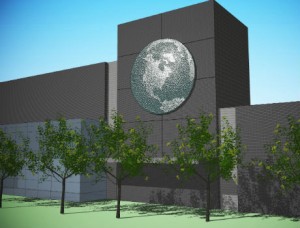 This piece by Aaron Stephen was to be installed at the side of the Performing Arts Centre where it would not get the exposure that was hoped for. There was an immense amount of detail for the public to take in but the height on the piece on the side of the building might have made it difficult to fully appreciate. A jury of local residents and cultural arts experts short-listed applicants to three finalists. More than 500 residents gave feedback, online and in person, on the three designs. After reviewing public comments, the volunteer jury selected the winner.
The jury included: Ian Ross, Executive Director of the Burlington Art Centre; Emma Quin, Executive Director of the Ontario Craft Council and Trevor Copp, Artistic Director of Tottering Biped Theatre
Because Burlington has difficulty with artists who don’t “come from here” it might be a useful exercise to show all 119 applications – let the public understand what the jury had to work with.
 The spiral will be 16 feel tall and will be outside the Performing Arts Centre for many,many years. How will Burlingtonians take to the piece and how will the artist decide what to “decorate the piece with? The nature of the Powning piece of art is such that Powning now needs to meet with the community and solicit objects that can be included in the final fabrication. This is a truly exciting aspect of the design. Clearly there will be lots of WW I and WW II medals brought forward for inclusion but what else will the residents of Burlington come up with?
We are about to see just how imaginative the residents of the city can be. Whatever is selected will be part of the sculpture that will be outside the Performing Arts Centre on Locust Street for many, many years to come. Hopefully the city will promote the daylights out of this and use every possible media and not just their favourites. If there was ever an event that could put social media to the test – this is it. City hall doesn’t understand social media and is to some degree afraid of it – this could be their opportunity to see if it will work for them
The artists might have a budget to get his need out to the public and the Performing Arts Centre could, hopefully, turn its promotional guns on this one. Whatever gets brought forward and used in this sculpture will be around for a long, long, long time. At least as long as the Pier and we are going to spend $20 million on that sucker.
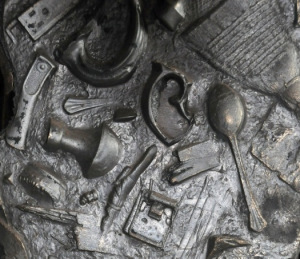 The objects in this illustration are examples of what have been used on other sculptures – this is an opportunity for Burlington to put its memorabilia on display and have it become a part of the public record. A spike from the old CNR line that ran along the edge of the lake? A can from the cannery that used to be on the water’s edge. The only limit is our imagination. Will someone put in a call to the Historical Society and get them involved?
Powning is calling the meetings at which residents bring in their objects “cultural mulch”. The artist will make a mould of the items chosen. There will be a significant number of items used. The molds will them be used to form the bronze castings that will be part of the final sculpture that is expected to be installed during the late summer of 2013.
There will be three “cultural mulching” sessions at the end of January and early February.
Central Library
2331 New Street, Holland Room Thursday, January 31 – 10 a.m. to 3 p.m.
Burlington Performing Arts Centre
440 Locust Street, Main Lobby – Thursday, January 31 – 7 to 9 p.m.
Burlington Art Centre
1333 Lakeshore Rd., Lakeshore Room – Sunday, February 3 – 2 to 4 p.m.
Drop by one of the sessions below with an item to contribute to the project. See it as something like one of those Antique road shows that are televised – but this time you’re not selling something or learning what its value might be you – you are becoming a part of the city’s history.
After his lecture in February Powning will be looking at objects people have brought in and. according to a statement from the city, casting the objects that day. People are asked to bring in just one object each.
Powning is not new to Burlington. His work is represented in the Burlington Art Centre’s Permanent Collection with five pieces. The city also saw some of his work during the East Coast Potters exhibit. His work is not currently on display but one can expect that to change.
Powning will give a short lecture about being an artist, whose work ranges from vessels to large-scale public art. He will talk about his experience responding to RFPs and working with municipalities/developers. An opportunity for Burlington artists to hear what a commercially successful artist has managed to do.
Spiral Stela continues the successful career of Powning who has completed several public art projects across the country and whose work can be seen at solo exhibitions worldwide.
This sculpture came to be when long-time Burlington resident and successful business owner Dan Lawrie, decided the Performing Arts Centre should have something outside the building and offered to fund a portion of the cost. Some members of city council wanted a bit more than Lawrie was prepared to put up, and the $37,500 cheque he did write isn’t exactly chump change.
The work is scheduled to be installed in late summer of 2013.

 By Staff By Staff
BURLINGTON, ON January 10, 2013 If there was ever any doubt on the message behind the Regional Police Lock it or Lose It campaign these photograph should convince you to lock you car and never leave valuables where they can be seen
A Beachway Park resident left a purse in a car that had a credit card inside it. The purse was stolen and the credit card used at a nearby ESSO gas station and at an area Best Buy location
On January 6, 2013 a purse was stolen from a vehicle at Beachway Park and a stolen credit card was later used at a. nearby ESSO gas station and at an area Best Buy location
 Police believe these two men are responsible for thefts from cars in the Beachway Park community and for the fraudulent use of credit cards stolen from those cars. On January 9, 2013 police were once again notified of a purse being stolen from a vehicle while parked at Beachway Park. An attempt to use a stolen credit card was made later that day at a Burlington business.
In the January 6th incident the suspects were observed in a 1999 Black Dodge Ram 1500 with an Ontario plate of AA76725 affixed. The truck had been previously reported stolen from the City of Toronto.
SUSPECT #1 – white, 30-35 yrs of age, 5’11”, average build with a fair complexion, wearing a black toque, brown plaid scarf (Burberry style), black waist-length coat, blue jeans and white running shoes
SUSPECT #2 – possibly south asian descent, 25-30 yrs of age, 5’10”, heavy build, wearing a black toque, plaid scarf, black waist-length leather jacket, blue jeans and white running shoes.
There have been car thefts throughout the region. Time to be more careful.
These are probably crooks from Toronto. Anyone with information that would assist in identifying the pictured individuals is asked to contact the Burlington Criminal Investigations Bureau at 905 825-4747 x2315, Crime Stoppers at 1 800 222-TIPS(8477), through the web at www.haltoncrimestoppers.com or by texting ‘Tip201’ with your message to 274627(crimes).

 By Pepper Parr By Pepper Parr
BURLINGTON, ON. January 10, 2013 When the Elementary Teachers Federation of Ontario (EFTO) announced they were going to hold a day of protest and not report for work the Halton Board had no choice other than to announce that schools would not be open.
The Board put out its notice which gave parents a scant 48 hours to find a place to put their kids for the day.
The protest on the part of the EFTO decision comes close behind an Ontario government decision to use Bill 115 (Putting Students First Act ) to impose contracts on teachers and education workers.
The teacher protest is against the Bill which was used by Ontario Education Minister Laurel Broten at the start of 2013 to impose contracts on teachers and education workers.
 This is what classrooms across the Region are going to look like Friday morning. Hopefully it will be bitterly cold while the teachers tramp up and down the side-walk outside. The teachers appear to be saying ‘we don’t give a damn’, we are angry and we want the public to know it. There will be all kinds of ‘toing’ and ‘froing’ about how irresponsible the teachers are while their union goes on about losing their democratic rights.
“The minister made a deliberate and provocative choice to wipe out the democratic rights of tens of thousands of educators rather than work towards a respectful solution,” said ETFO president Sam Hammond, in a news release.
“She could have taken our olive branch and waited for a new leader to try to find solutions, but she chose not to.”
Meanwhile parents scramble.
Museums Burlington is doing their bit to help out by opening up their community resource and offering their Museums as a program facility and service for learning and play on Friday January 11, 2013. They quite correctly called the service a Strike Camp – useful helping hand on the part of the Museum people.
Their program day would take place from 9:30am to 3pm at Joseph Brant Museum at a cost of $20 per child, not including lunch or refreshments.
You can get more information at 905-332-9888.

 By Pepper Parr By Pepper Parr
BURLINGTON, ON. January 8th, 2013 The “new” Waterfront Committee is certainly different from the one that had its wheels taken away from it.
The city decided to sunset the Waterfront Access and Protection Advisory Committee that was created during the Cam Jackson era. It was a good idea that was politically motivated (nothing wrong with that – just recognize why it got created in the first place) and it never really got a chance to find its way. The city tired of it, used an administrative reason (duplication) to get rid of the thing and it was a dead duck. Those dead ducks weren’t prepared to give up quite that easily and with the help of Ward 2 Councillor Marianne Meed Ward they reconstituted themselves as a citizen led committee on the Waterfront and have set up shop in the office of the Councillor.
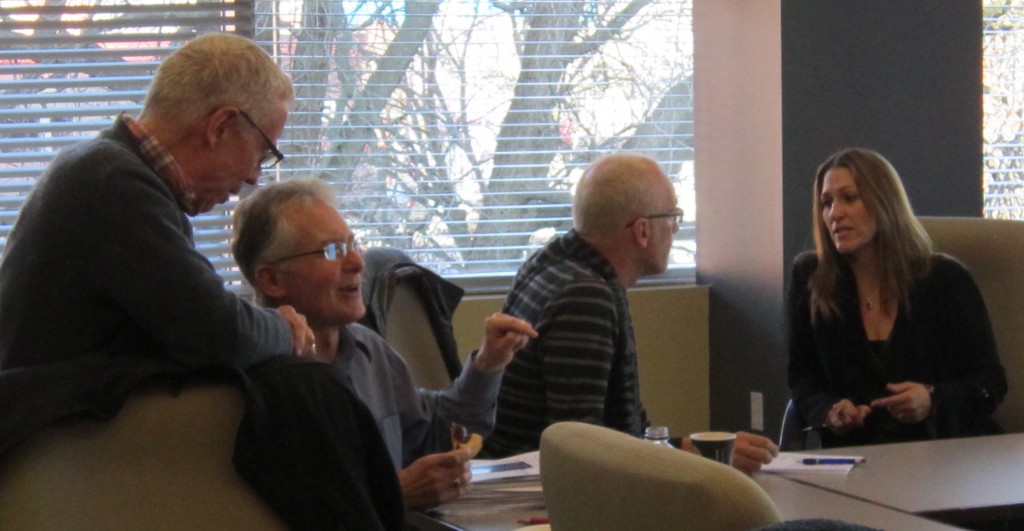 The old gang decided they had a good thing going and who cared if the city sunset them – they would continue to do their thing under a different name: Bob Wingfield on the left with Gary Scobie, Jeff Martin and Marianne Meed Ward who decided she would convene a waterfront committee. Too early to tell how this might pan out but they have already done a couple of things the sunset committee wasn’t able to do – and that is communicate with people. They have created a Twitter account and expect to have their very own Facebook page in place soon. City policy didn’t permit Advisory committees to communicate directly with the public. Burlington is still taking baby steps with a technology that has swept the rest of the world. The people responsible for communications and communications policy at city hall haven’t managed to understand the role social media plays in the way the rest of us communicate.
The “new” Waterfront committee also made the important decision to meet in the evenings when it is convenient for the public to attend. Most of the original committee made the move to what is now to be known as the Burlington Waterfront Committee (BWC). They now need to determine who their chair will be and have taken a rather unique approach to this task. There will be a person that “convenes” the meetings, but that person will not be the chair. This was due, in part, to make it clear that while Ward 2 Councillor Meed Ward has her fingerprints all over this group – it is not a Meed Ward organization.
Someone else will be the chair and serve as the spokesperson. Bit of a problem at this level in that there isn’t much in the way of actual leadership talent on the committee. The members, and there is representation from each ward, are decent, passionate waterfront people with a deep, genuine concern for what happens to the waterfront. Being passionate about something doesn’t necessarily equal leadership.
The one person who can do that job is Bob Wingfield who so far hasn’t volunteered but just might accept a draft if his fellow committee members push hard enough. Wingfield could handle this for a few years, might take as much as three, while he develops and nurtures new and younger talent on the committee. Right now I don’t think there is anyone under 55 on the committee – with the exception of Meed Ward.
The committee is creating its strategy; it has a full list of things it wants to get done – many of which are holdovers from the original committee. The new Burlington Waterfront Committee (BWC) is not there to advise – it can now advocate and push for solutions to some of the stickier waterfront problems.
The matter of access to the waterfront is one that needs attention. City hall is sitting on its hands over both waterfront encroachment issues as well as access issues. There are people along the waterfront who have put up barriers that prevent others from getting to the edge of the lake on what is city property. The BWC can now delegate at council meetings and push for some action.
This version of the waterfront committee thinks in terms of a budget and talks about fund-raising whereas the old committee didn’t see itself spending the $5000 budget it had.
Meed Ward moved $500 of her 2012 $9000 expense into a trust account at city hall and ear marked that for BWC and then, just as soon as the New Year was legit, she moved another $500 over giving the BWC a total of $1000 to work with. There was the suggestion that council members from each ward might want to allocate some of their expense allocation to the committee. Ward 5 Councillor Sharman and Ward 2 Councillor Craven have waterfront interests. Be interesting to see how they respond.
This newly created committee just might be the vehicle that opens up the current Advisory committee system the city has. Heritage Burlington has done a superb job on how to preserve the heritage properties we have.
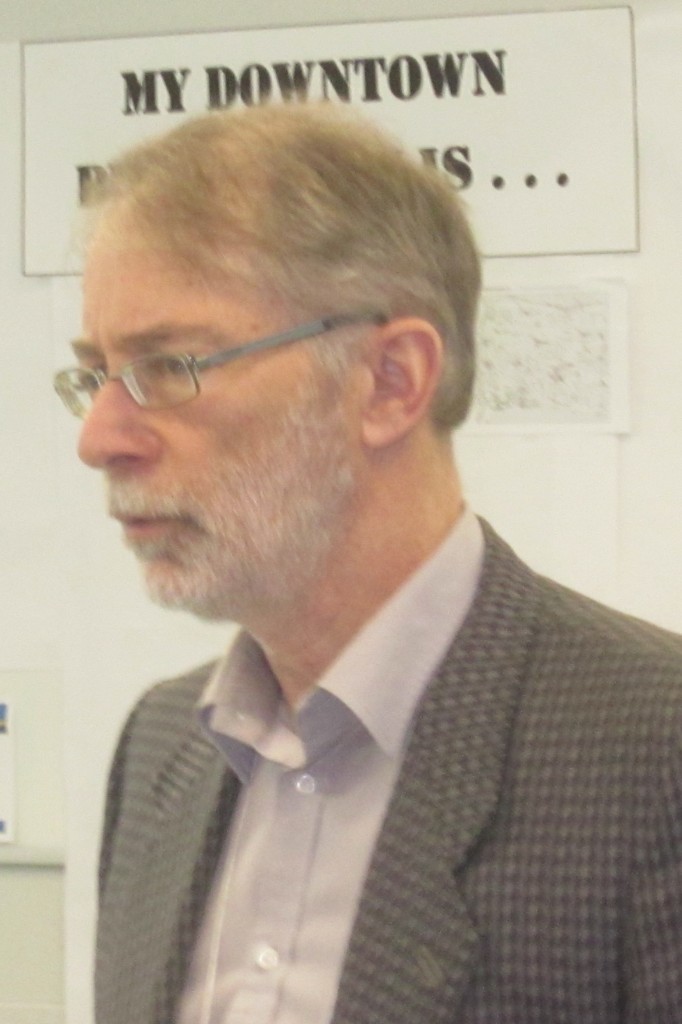 Brought in specifically to lead the review of the Official Plan Gummo got off to a very good and very strong start; the city was about to see a much different and more agressive review of its Official Plan than it had in the past. The original committee had difficulty getting traction on a number of key issues that related to the city’s Official Plan which was up for its five-year review this year. They decided that Old Lakeshore Road issues and waterfront access could be taken to the Official Plan Review (OPR), which was a great idea. The OPR has stumbled with the very sudden “retirement” of Alan Gummo. Many expect that the OPR schedule is going to slip by as much as six months and perhaps as much as a year. Unfortunate; Gummo was providing just the kind of leadership this task needed.
In putting together their budget the committee penciled in funds for speakers suggesting they want to invigorate the community with new ideas and get a real dialogue going. That is going to need some fund-raising which this group seems more than prepared to take on.
It is indeed a much more focused committee that should serve the waterfront interests of the city quite well.
The Terms of Reference they are creating puts one little wrinkle into the longer term plans – the Ward 2 Council member is a large part of what the committee is setting out to do: what if the Ward 2 council member is challenged at the next municipal election and loses?

 By Staff By Staff
BURLINGTON, ON January 8, 2013 One of the busiest thoroughfares in the city is going to get squeezed a bit which will reduced the flow of traffic, while the Region replaces the waste water main crossing on Guelph Line just north of Mainway
This project is expected to be completed by the end of January.
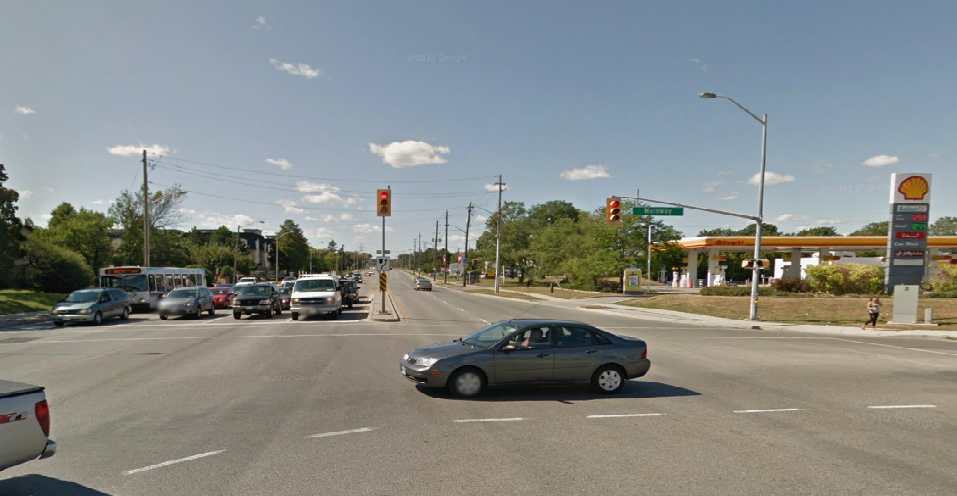 These traffic lanes are going to be narrower for the balance of the month while waste water mains are replaced. You might want to look for alternate travel routes. Construction will take place north of Mainway. The project starts on the 10th – and is expected to last till the end of the month. Look for lane restrictions and delays. Emergency vehicles will get the priority they need.
The Region refers to this necessary work as part of Building a Better Halton, the Region’s infrastructure construction plan for roads, water, wastewater, and waste management projects across Halton Region: Happy talk at its best.
The flow of traffic north and south on Guelph Line is significant during the rush hours – for those who can, looking for an alternate route into the core and back home might be a good idea.

 By Pepper Parr By Pepper Parr
BURLINGTON, ON. January 8, 2012 This is one of those jaw dropping stories. Bookmark it and take the time to go through the whole thing. Amazing, absolutely amazing.
A group called the National Oceanic and Atmospheric Administration has created a room sized, global display system that uses computers and video projectors to display planetary data onto a six-foot diameter sphere, analogous to a giant animated globe.
 This isn’t a photograph of the earth but instead it is a globe shaped computer screen on which the earth has been projected. All kinds of data can be projected on this kind of computer screen that comes in models up to 3 metres wide. The data can be a live feed from a satellite. Consider the possibilities? They call it Science On a Sphere® and promote it as an educational tool to help illustrate Earth System science to people of all ages.
They project data on this room sized globe and then move the globe around so that you can see this world of ours from different angles. With the globe in place they can display all kinds of data on the thing. If your child’s science teacher doesn’t know about this – make sure you tell them.
 This is an image from that globe shaped computer screen of live cloud data fed from satellites that show the formation and movement of clouds. How weather moves around the globe is displayed and you can see the changes taking place right before your eyes.
 Remember now – you are seeing an image on a computer screen that is very large and shaped like a globe. The image you see here is of the warm water currents, shown in light green, as they move down the west side of Africa across the Atlantic. What does that do to our weather patterns? Ever wondered what the “gulf stream” really is and how it affects our weather. You can see where it originates and how the flow of warm air moves around the globe.
You can see whatever data is put up on this huge globe. The educational opportunities are incredible. Information about the impact of air pollution, water pollution – the impact of the changing seasons on our world – there to be seen right before your eyes.
In one segment they show how the continents on this earth were formed. This is absolutely amazing stuff. Animated images of atmospheric storms, climate change, and ocean temperature can be shown on the sphere, which is used to explain what are sometimes complex environmental processes, in a way that is simultaneously intuitive and captivating.
These things are not cheap. They cost around $43,000 for a 24-inch diameter HyperGlobe from iGlobe of Franklin, N.H.; $40,000 for a 32-inch OmniGlobe from ARC Science of Loveland, Colo., or $21,000 for a 24-inch Magic Planet from the market leader, Global Imagination of Santa Clara, Calif.
The Halton Board of Education isn’t going to pony up that kind of money (but if they let one of the bureaucrats go – maybe?) The prices, though, are falling. Mike Foody, the C.E.O. of Global Imagination, says that he hopes to have education-discounted prices down to $2,500 within a year or two. If he succeeds, that would be within the price point of other high-tech classroom equipment, like interactive whiteboards.
A digital globe can illuminate the human planet and display whatever we want in the way of data: wars, colonization, and the formation of diaspora, modern trade flows or air traffic.
While this stuff is not brand new, been around since 2010, scientists and educators are now getting a sense of just what they can display in terms of information.
It won’t be long before this kind of data display will be part of every news source. Instead of having the oil lobbyists tell us that the tar sands are not harming the environment – we will be able to see the actual changes – live – of the impact the tar sands are having on the environment. We will be able to see crop failures as well as bountiful crops.
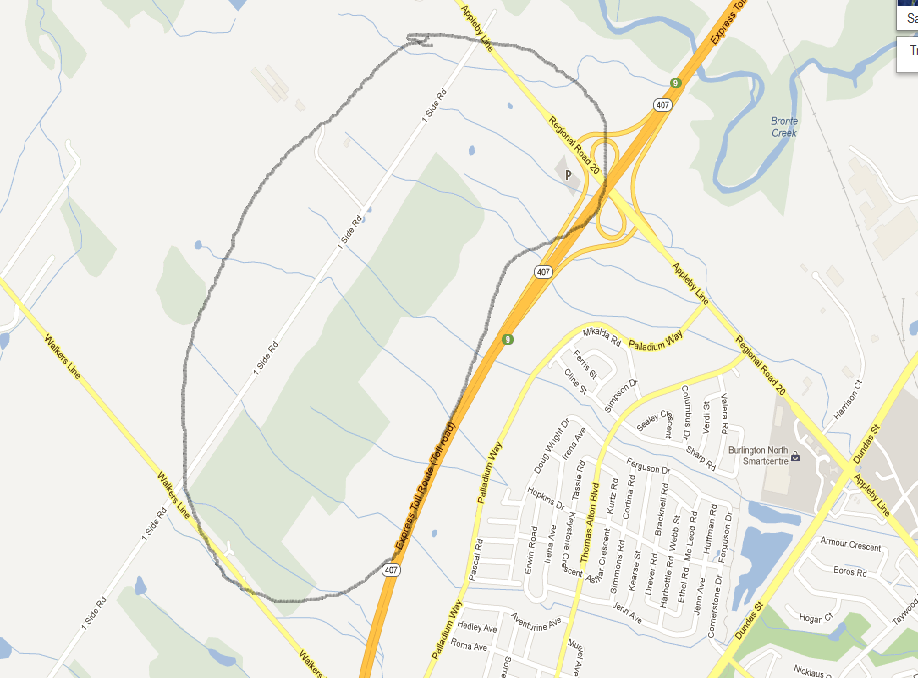 This is the area any pipeline break would impact. The actual pipeline runs through the northern part of the city north of Side Road # 1 and south of Side Road # 2 To bring this down to a purely local level, consider the very real concern about what Enbridge, a national energy transportation company wants to do with the pipeline they own that runs through north Burlington. Enbridge is a powerful North American oil and natural gas transportation company. The gas heating your house is delivered to your door by Enbridge.
They have pipeline projects being developed throughout North America. Some analysts think that Enbridge has figured out they will not be able to get a pipeline though western Canada to get Alberta oil to the far east – so they want to use the pipelines they have to move that oil to eastern Canada and on into the United States where there is a strong market. These guys are big.
The pipeline they want to do that with is a 37-year-old line that runs through Burlington between #1 Side Road and # 2 Side Road.
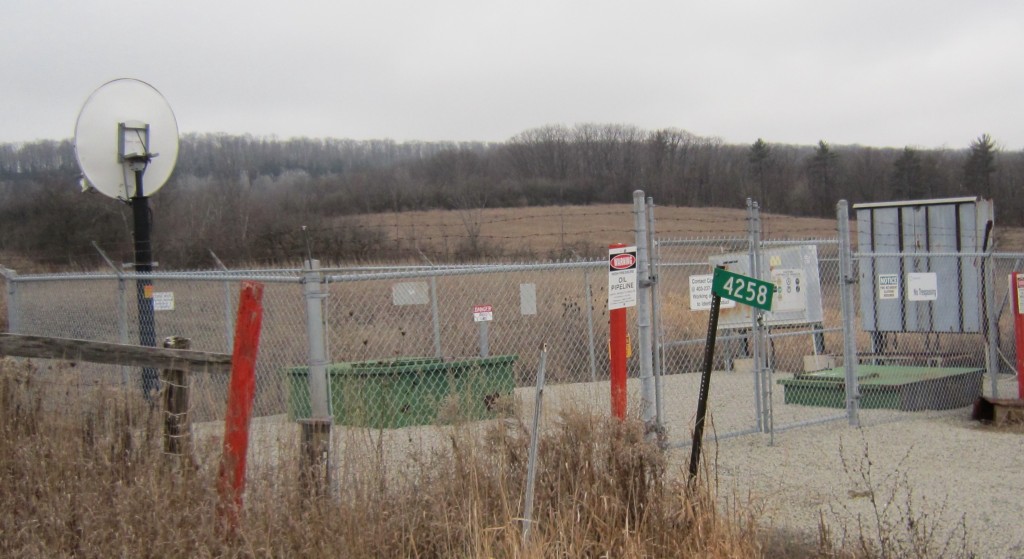 Part of the Enbridge #9 pipeline where it crosses Walkers Line. The company wants to reverse the flow of oil through this line so that it goes from west to east. Reversing the flow in a pipeline is no small matter. This line is more than 37 years old. What kind of shape do you think it’s in? Enbridge is seeking permission to be able to reverse the flow of oil through their pipeline – not as simple as it seems. And they want to ship bitumen from the Alberta tar sands through to Montreal and points eastward. Problem for Burlington is, there are creeks galore that run south of that pipeline – right smack into our communities and on into Lake Ontario.
Were that pipeline to burst – and where have we heard of pipeline bursts before – parts of this city would be severely damaged. City hall worries about who is going to pay for any clean up that might have to be done.
As you can see from the still photo’s we have posted there is certainly a pipe line there but we can’t show you the connection to the different creeks and then follow those creeks in real-time down to the lake.
While on the matter of that Enbridge application – it is going to get messy. Hamilton has been dealing with Enbridge on a different application and has found the company very difficult to deal with.
Mayor Goldring, a staunch environmentalist, wants to do something but isn’t quite sure what the first step should be. The federal government has cut back severely on the number and circumstances under which environmental assessments take place – they have basically taken themselves out of that business. Don’t expect to read anything about this in the Newsletter our MP, “Marvelous” Mike Wallace sends to you at your expense.
The province could decide that it wanted an environmental assessment done and the Region could get creative and look for ways to cause an environmental assessment to take place. Problem is the Region isn’t all that a creative place these days.
Ideally, our MP should have met with our Mayor by now to work together to find a way to, first get the facts and inform the citizens, and then figure out what the city can do to protect its citizens.
BurlingtonGreen is advocating heavily for a public meeting. The key player in all this appears to be the National Energy Board (NEB) that decides if Enbridge gets permission to reverse the flow of oil in their pipeline and also decides if they are going to be given permission to move bitumen from the tar sands though the pipeline.
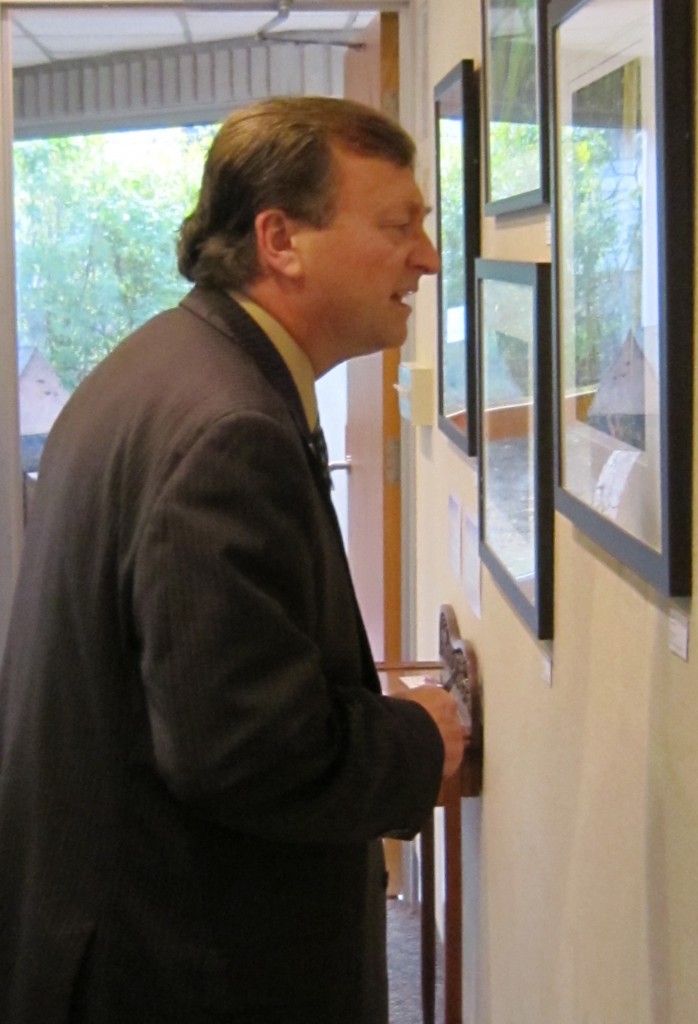 Burlington’s Member of Parliament Mike Wallace takes a close look at a piece of art while taking part in a photo-op that had him announcing the opening of a kiln at the Art Centre. There are some in the city who think the MP might involve himself in taking a closer look at an oil pipeline application that could negatively impact the city. Burlington could invite the National Energy Board to town and talk to the public. The NEB is a federal agency; our MP “Marvelous” Mike could make some of those phone calls on behalf of the city to set up a meeting. He may have already done that – ya think?
What Burlington wants to know is: what shape is that 37-year-old pipeline in? Dig up a section and let’s have a look at the condition of the pipe. And then do a study of what the impacts would be if there were a break in the line should they be given permission to move bitumen through that line.
Any study done would be a report printed on paper with maybe a video as part of the document. But if there were a way to put current data on one of those globes and put that on-line where anyone at any time could log in and see for themselves what is happening – that would be great new age journalism; great public education and as educational as all get out.
Researching this would make an ideal high school science project. The full story of what the Science on a Sphere was published in the New York Times.

 By Pepper Parr By Pepper Parr
BURLINGTON, ON January 7, 2013 Is it because we are the second nicest city in Canada to live in? Is it because we perceive the city to be a safe place so there is nothing to worry about. OK, so there are a few break ins, some small thefts but we don’t have a crime problem do we? Our homes are safe places and our cars are safe in our driveways – aren’t they?
Apparently not. Halton Police recently arrested a man and charged him with 17 offenses – all related to breaking into cars – and there wasn’t much breaking in to do – most of the cars were left unlocked.
On January 3, 2013 at 3:30 a.m., an alert citizen, in Acton, contacted police to report a man breaking into vehicles on his street.
A concerted response by uniform officers resulted in the quick arrest of an Acton man who when apprehended, was in possession of several stolen items.
The investigation to date has determined multiple vehicles were entered on Greenore Crescent, Cameron Street, Kingham Road, Church Street East, Gould Crescent, Wright Avenue and Birchway Place all in Action. If it is happening there – it can happen here as well
Jeffery McBEAN, 26 has been charged with 17 counts of Theft under $5000 and two counts of possession of stolen property.
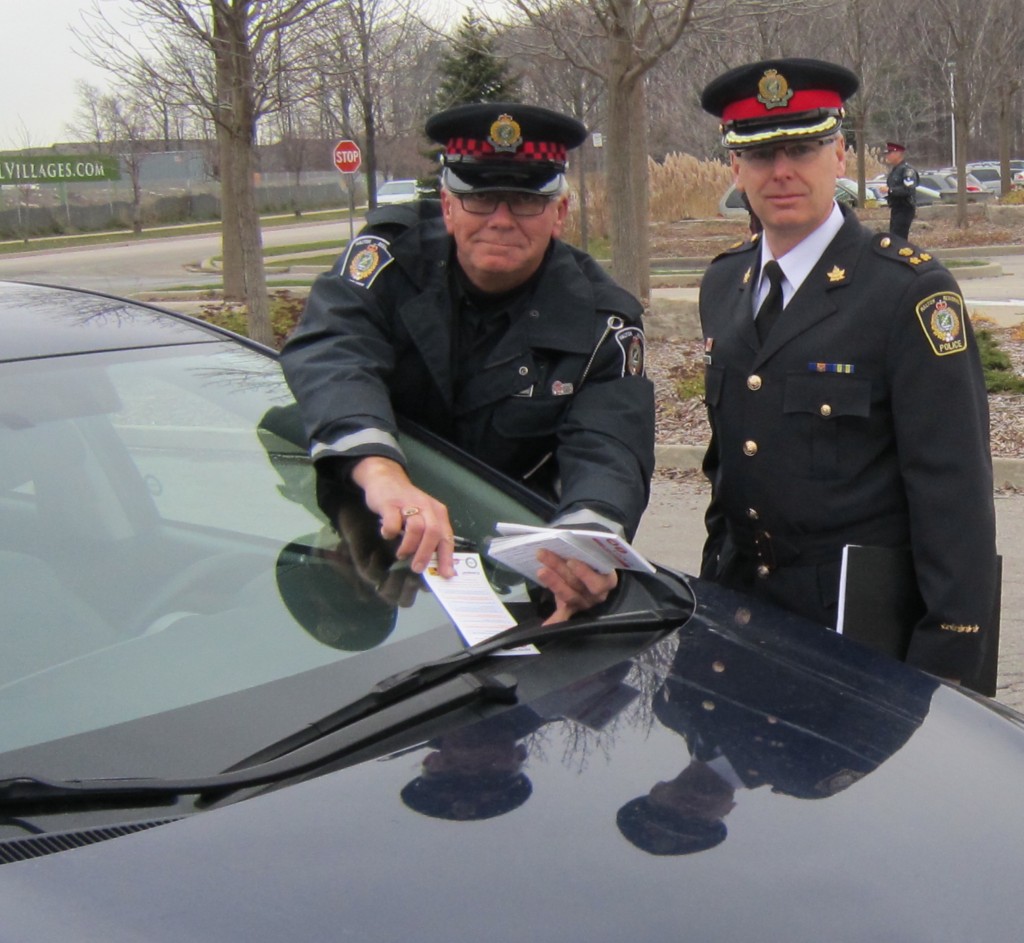 Deputy Police Chief Andrew Fletcher (he’s the one with all the gold braid) and Auxiliary police officer Voorberg putting a notice on a vehicle that had objects of interest to thieves. This was the kick off of the Lock It or Lose It campaign. The vast majority of the incidents involved vehicles that were left unlocked, this despite a recent Provincial Campaign, ‘Lock it or Lose it’, aimed at urging motorists to lock their vehicles and keep valuables out of sight.
These particular crimes are largely preventable by simple crime prevention techniques including:
– Parking in an enclosed garage OR well lit area.
– Never leave valuables in plain sight OR remove from vehicle entirely.
– LOCK your vehicle.
Residents in the Alton Community, north of Dundas and west of Appleby Line, have a system that allows one person to tell others electronically that something is going on. The Alton resident’s, who have organized themselves with an electronic service that gets word out on problems in the community, sort of like an electronic Neighbourhood Watch, recently sent out an alarm and the person breaking into cars was nabbed.
This reporter was taking part in the media event at which Halton Police launched their Lock It or Lose It drive and got a notice from police on the spot that he had left a purse sitting in the front seat of the car and got a warning notice.
It is surprising that cars being broken into are not stolen as well.
Lock it or Lose It – these guys are out their – 17 charges – that’s going to keep this one off the streets for a period of time – hopefully.

|
|




























































































